Two weeks in the Falkland Islands: a diary from the land of penguins
This website uses affiliate links which may earn a commission at no additional cost to you. As an Amazon Associate I earn from qualifying purchases.
Updated: 19th January 2020
My visit was in partnership with Falkland Islands Tourism
I’ll be honest: my main reason for visiting the Falkland Islands was penguins. Lots and lots of penguins. For some, a dream work assignment had landed in my inbox; for others, they would have scratched their head and pulled out a map to place these obscure islands and, truth be told, I did have to brush up on both my geography and history before this trip.
People had told me to enjoy my time in Scotland or how jealous they were I was going on a tropical escape – so I’m not exactly going on a whim by saying a fair few people don’t know where this archipelago was (here’s a handy map link if you are in that boat).
I tried to research as I would for a typical trip before committing, but the internet came up short. The wildlife was well documented in close-up, and the haunting and bleak images of the 1982 war were still in prime position on the Google rankings – but there wasn’t really anything telling me how it felt to travel to these far-flung outposts beyond red phone telephone boxes and mugs of tea stereotypes. I wanted to know what the Falkland Islands experience would be like, but the more I searched, the more confused I became about what to expect from one of the world’s most unique island destinations.
So I decided to say yes to the assignment with the tourism board and write a diary. I guess it could be an itinerary of these wildlife-heavy islands, although I would mix up what I did a little, as you’ll see in my Falkland Islands travel guide, but more so, I wanted to detail how it felt, how I felt, and what it was actually like to travel to these islands and, most importantly, to answer the question: is a journey to the Falkland Islands worth it?
So here’s how my two weeks on the Falkland Islands went down in 2019, starting in a very unexpected way.
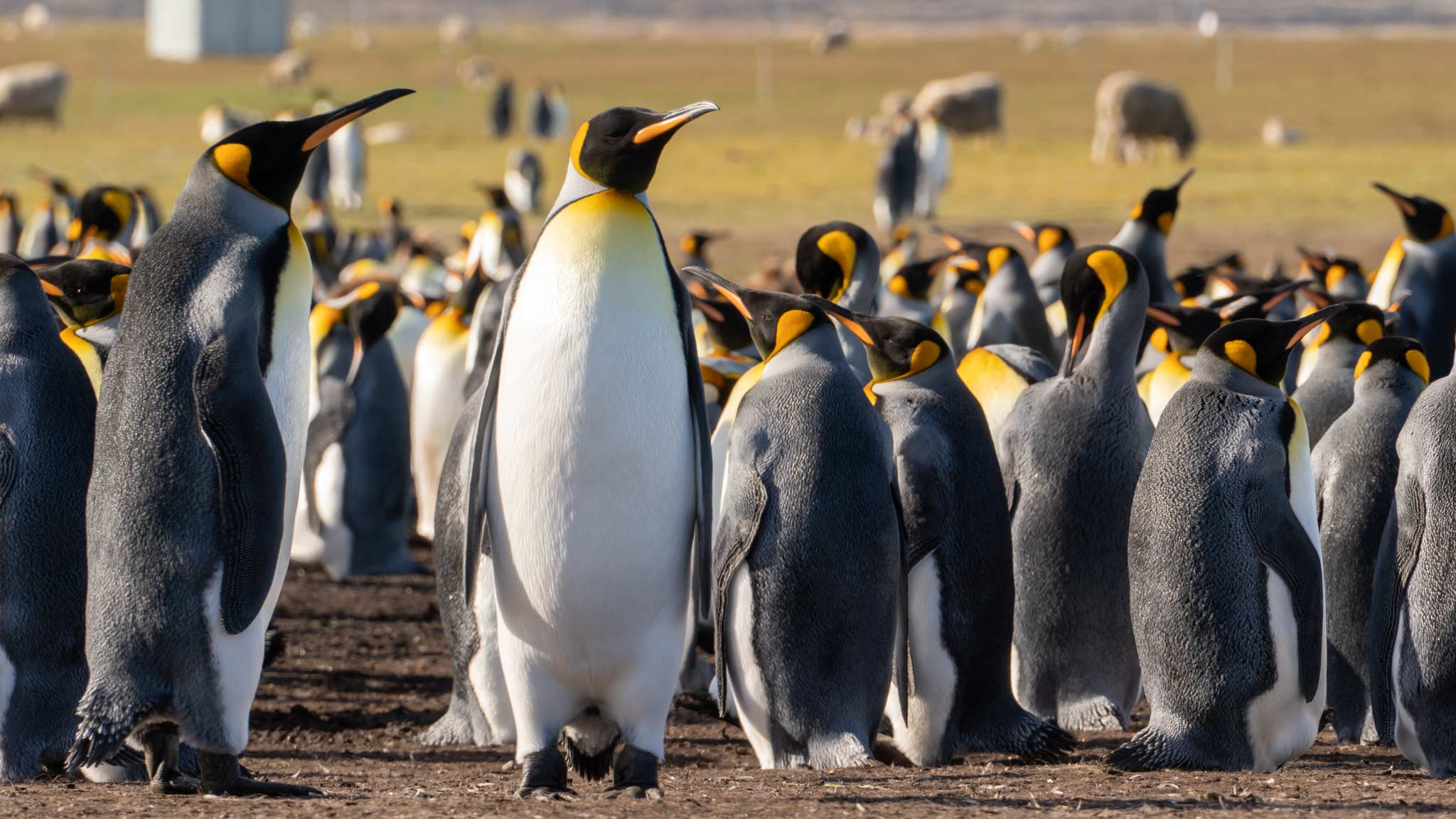
Day One: Why am I at an army base?
‘Is that a window seat?’ I asked the camouflaged lad behind the desk. The last flight I had been on, where the crew dressed in army-style gear, was VietJet, where the flight attendants wore hot pants and used to do a sexy little dance when the safety briefing was on.
‘No’ was the surprisingly patient reply. ‘But you’ve got a spare one next to you’, he said with a sympathetic nod. These guys, however, weren’t playing sexy dress up; they were fully-fledged members of the RAF, and I was right in the centre of a military base near Oxford, in England.
Up until now, this has been the only main connection from the UK to the Falkland Islands, a remote archipelago in the southern depths of South America that falls shy of the Antarctic Circle. The weekly airbridge service, with its seemingly common delays, well-documented lousy food, and once upon a time staffed by squaddies on a Hercules who would reluctantly dish out tea and sandwiches, ferries army personnel, locals and freight back and forth. A small selection of those seats are available for tourists to purchase. Another weekly flight also leaves Chile for the army base in the Falklands.
My plan was never to be on this flight, though. This month was meant to be bringing exciting news. A new, international departure with LATAM to the remote islands from São Paulo, which meant better connections for all of us through their extensive flight network, cheaper flights, and no need for the increased security checks, early check-in times, and hard-to-arrange flights with the RAF from an obscure airstrip in England.
Alas, that inaugural was delayed for me, but for you, my friends, that option awaits. For those wondering, the flights were pretty standard, on the way back the seats were randomly embossed with the Jet2 stamp. With a stopover in Cabo Verde, we would arrive some 19 hours later at a place I really had no expectations of – except those cute waddling penguins that Pingu, a kid’s TV show from the 90s, had made me obsessed with for life.
Just before landing, a safety video popped up on the few and far between screens above us, and an info film that could well have been made in the 90s came on advising us about biosecurity, the wildlife country code, and not to go for a jog on the airport runway. At this point, I started to wonder just how far we had travelled. Was it closer to 19 hours or 19 years? Visiting the Falkland Islands is like stepping back in time, but not in the bad way you might expect.
While in these remote islands taking a run on an airstrip runway might be an accidental norm it appeared, I quickly learnt the islanders themselves were made up of some 50 odd nationalities, had overwhelmingly supported legalising gay marriage with a 90% yes vote, and solar and wind energy powered much of the islands. The tea and cakes may be old-fashioned, but the personalities and goals of the locals certainly weren’t – something you might not expect from a place seemingly disconnected from the world.
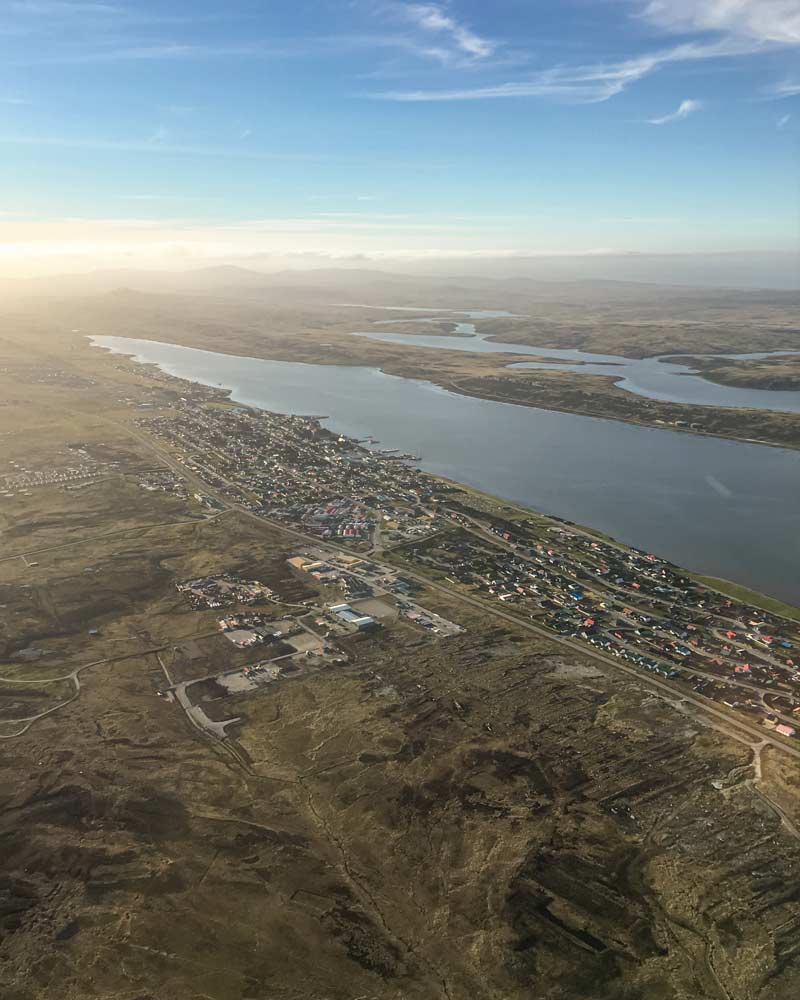
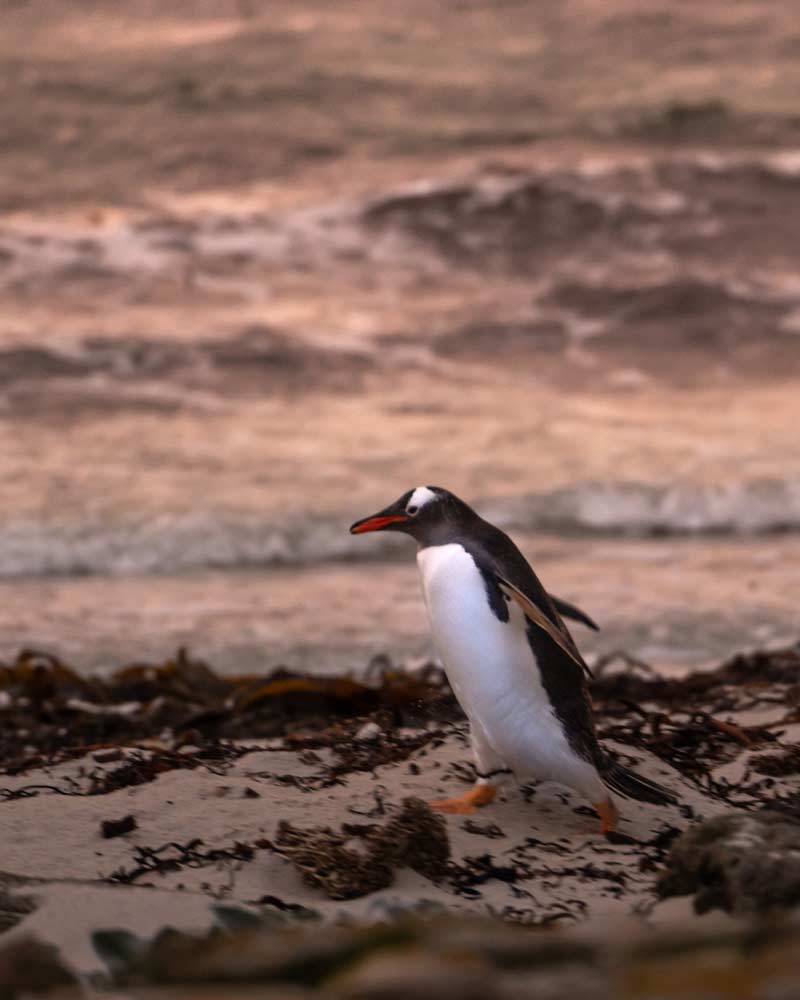
The history of the Falkland Islands, which came to a dramatic head in the 1982 conflict with Argentina, is well documented, so I’ll let you do your own reading. But unlike as I assumed, being English and well aware of the enslavement, colonisation and murder that my country inflicted on much of the world, the Falkland Islands had no native population, and the British claim to the islands and many of its settlers actually dates back to before Argentina existed in name. Between the French, English and Spanish, these islands briefly passed hands, but with nearly all the 2000-plus islanders wanting to remain part of Britain, the idea of handing sovereignty to Argentina raises an obvious question: surely, that would be creating a 21st-century settlement problem in itself?
It’s for this reason you land at a military airport here, Mount Pleasant, where the military personnel and presence have stayed in the four figures since the surrender in 1982. And on the matters of sovereignty and politics, I will say no more for the rest of this read – as there is plenty of that already online.
We bundle into a tiny hall where civilians line up on one side and army, marine and RAF queue on the other. I heard from some it was the most boring placement in the world, and others who relished in the wild nature of penguins over a war-torn tour in another land.
Whoever you fly into the Falkland Islands with, it’s here you’ll land – and can book onto the bus to take you into Stanley, arrange a driver, or maybe even switch straight onto one of the small islander planes that ferry locals and tourists to one of the outer lying islands.
Once stamped through – although it may be British in defence and foreign affairs, the islands have their own government and control, meaning my UK passport still needed stamping, and I couldn’t just turn up and find a job – our luggage eventually appeared on the singular convey belt after some kind of drama with chickens on the plane.
In years gone by, it would be here where you’d get a briefing and map of where the many landmines across the islands were buried and a dramatic recount of what each type would do to you.
Now, nearly 40 years on from the war, the mines have been removed thanks to a hardworking team of mainly Zimbabweans. Driving out of the airport, I could see the odd stretch of uplifted dark soil, dutifully removed by the de-miners, and thankfully, detailed maps had been kept of where they were all buried.
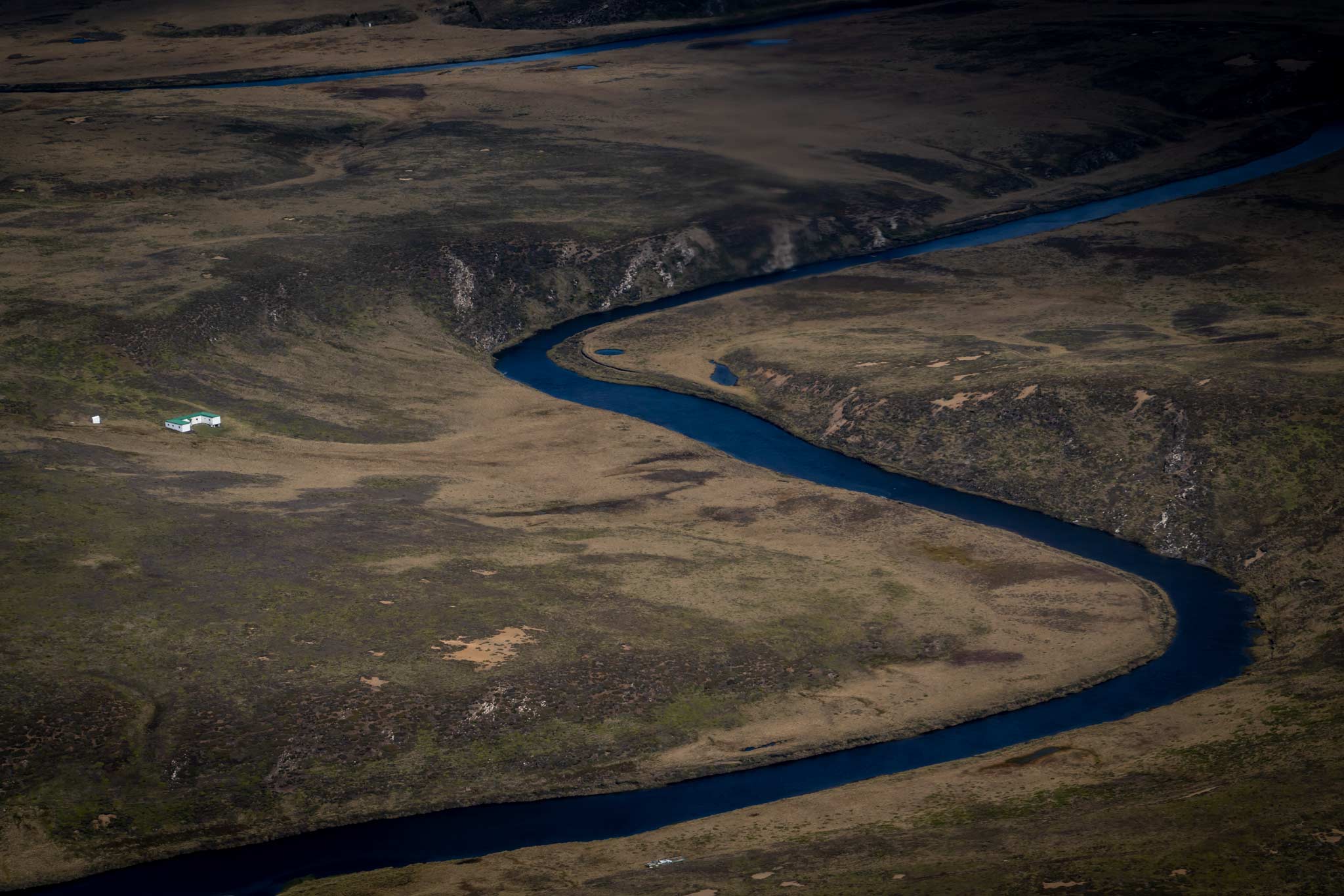
‘There are trees everywhere, and I love it,’ Tina, my friendly guide–come–driver–come–pal from the tourist office, grinned as we talked about England on the 40 miles per hour road that links the airbase with the capital. Sporadically, the ground would change from smooth tarmac to gravel, and I quickly learned this was about as good as roads, or indeed runways, got over here.
Looking around me I realised why trees would excite anyone that much, there weren’t any here. Rocks, mountains, green tufts of grass, and the local plant, Diddle–Dee, hugged the terrain, but there wasn’t a single tree in sight. Later on in the trip, when I got caught out looking for a ‘bathroom’ in the wild, this would become a problem, as you couldn’t simply ‘go behind a tree here’. You’d have to embrace the open. Luckily, the only eyes likely to spot you would be that of some of the 400,000 sheep here or half a million pairs of penguins.
After an hour, we passed through the mountains where the final battles of the 1982 conflict had been fought and pulled into the capital city, Stanley.
Colourful Scandinavian-style houses with corrugated metal roofs spread out on the downward hill, with some traditional British stone townhouses and the occasional pub in between them.
We checked into one of the only full–service hotels on the islands, the Malvina (without the s, it’s an old Scottish name not to be confused with the Argentinian name for the islands, which in itself is a French derisive of St Male, and dates back to the English invasion of Quebec), House Hotel. A bit delirious from the flight, we headed to the restaurant to grab a quick bite to eat. Chowing down on Fish and Chips doused in vinegar, I spot a red telephone box and postbox out the window.
Was I mad to travel all this distance to sample things so similar to my birth country? I pondered as I dozed off, listening to the lapping of water in the harbour outside.
I guess the next ten days would answer that.
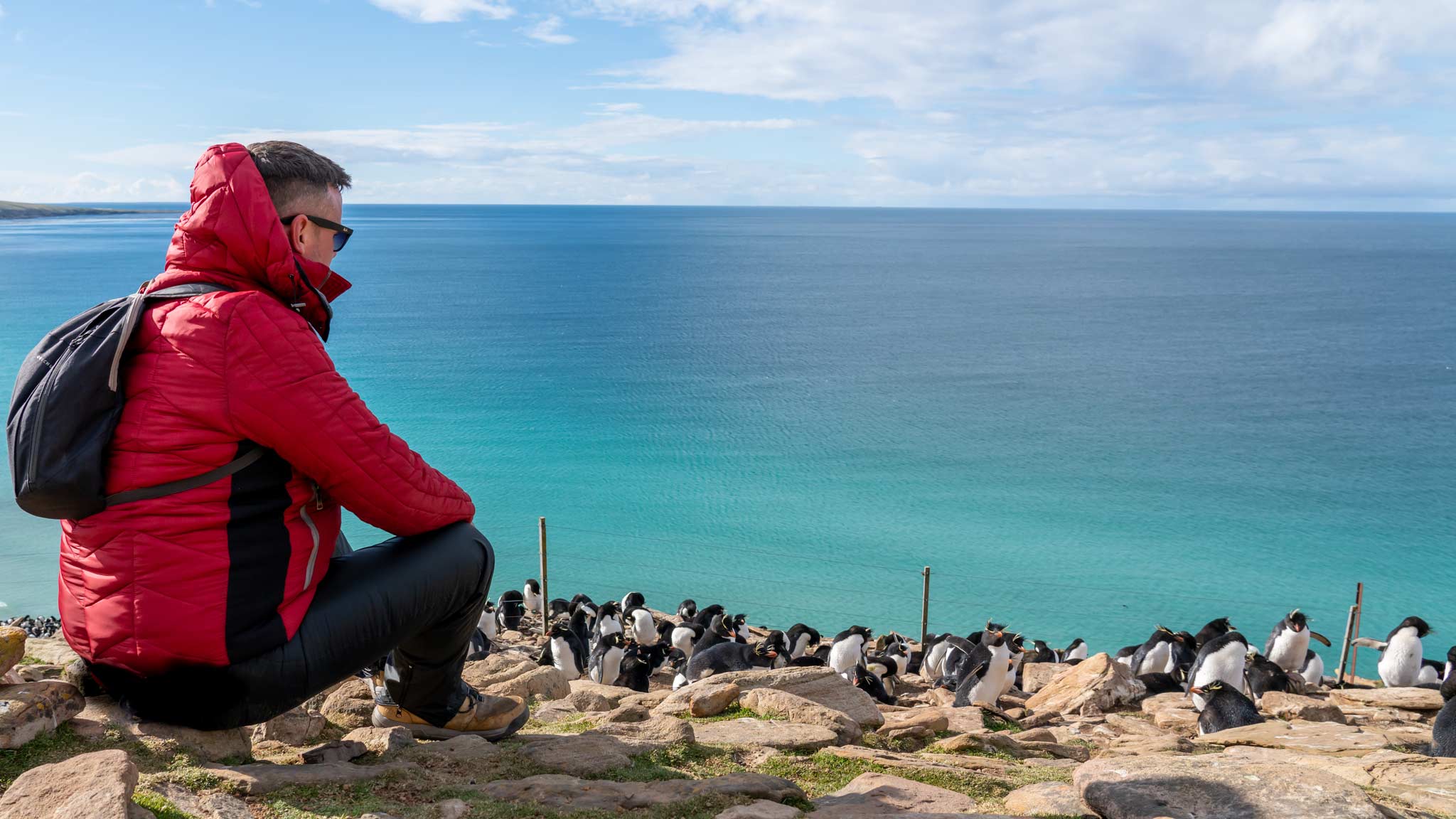
Day two – An army cabin ‘hostel’ surrounded by penguins on Saunders Island
Well-rested and well-fed from breakfast, Tina dutifully picked me up and sped me down to the small airport and landing strip in Stanley. It is from here that the local airline, FIGAS, has its handful of planes based, and flying domestically follows a whole new set of rules.
Firstly, you don’t book a specific flight. You send your request of where you would like to go and where you are coming from and can give a preference of morning or evening. Then, the day before, the crew work out all the different stops they needed to make around the islands, the routes they would take, and which passengers would go when and where.
This is, of course, also dictated by the weather. While, say, Stanley might be sunny and calm, gale-force winds and mist might be occupying an outer island. The spread of this archipelago is deceptive, given the tiny spot they occupy on a world map.
Once that is all done, the local radio news station will read out the flight times and passenger names so you can listen in or wait to get a notification from your travel agent. I think it’s fair to say at first, this all baffled me, but it quite quickly became the norm.
Tina helped me take my bags in, which were overweight, but with the cost being about £2 per extra kilo at the time of writing, it didn’t break the bank. The passengers are then weighed so the pilot can distribute the weight in the small eight-seater aircraft properly, and then you head onto the last tarmac landing strip you’ll see for a while and board these red and blue planes that seem to be able to fly in nearly all weather conditions.
Our pilot, Tom, gave me a quick safety briefing that all the locals were well versed in. Once airborne, the terrain and views quickly changed. From the rocky mountains around Stanley to silver and white sand beaches, rugged rocks with crashing waves, lush green farms and, in between, the occasional settlement, some with just a population of two. I was already blown away; everything was more vibrant and beautiful than much of the Falkland Islands photos I had seen in my research.
My first destination was Saunders Island, and after a quick stop at another to drop off a local passenger and their new kettle, of which getting those extra stops is fantastic for photography, we landed on a bumpy stretch of grass, and I was greeted by Sue and Robert, the owners of this island farm where they lived with their daughters.
Pleasantries were exchanged between the pilot and locals, and as the small aircraft was airborne again, the windsock came down, the little fire truck was put in a garage, and the ‘airport’ hut was closed for another day. I dipped my shoes in some biosecurity cleaning fluid, and we bumped our way over the grass to the main settlement, where a couple of great photographers, David and Carol, joined us in the car.
We were all heading to stay at The Neck, one of three accommodation options on the islands; being self–catering and an hour away from the nearest human, I’d stocked up on supplies in Stanley while my new friends had gathered theirs from the tiny shop on the farm here.
What I didn’t realise as we jerked over mossy hills, avoiding wet ditches and truly off-roading, was I was about to experience one of the best days of my life.
The drive down to The Neck took around an hour or so, with us all taking turns to jump out and open and close the seemingly high number of farm gates. As Sue rolled down the final hill to where the land thinned, and powder-white beach fanned out on either side, I saw countless white dots in the middle.
Penguins, and not just a few of them, penguins absolutely everywhere! We took a slow drive along the sand, carefully avoiding any nests, and passed a group of fluffy king penguin chicks. My heart jumped with joy. Was this real life, or was I still on an army plane dreaming of some penguin utopia? I wound down the window and breathed in the fresh salty air as an aggressive wind slapped my face.
This was real, yet I genuinely couldn’t believe it.
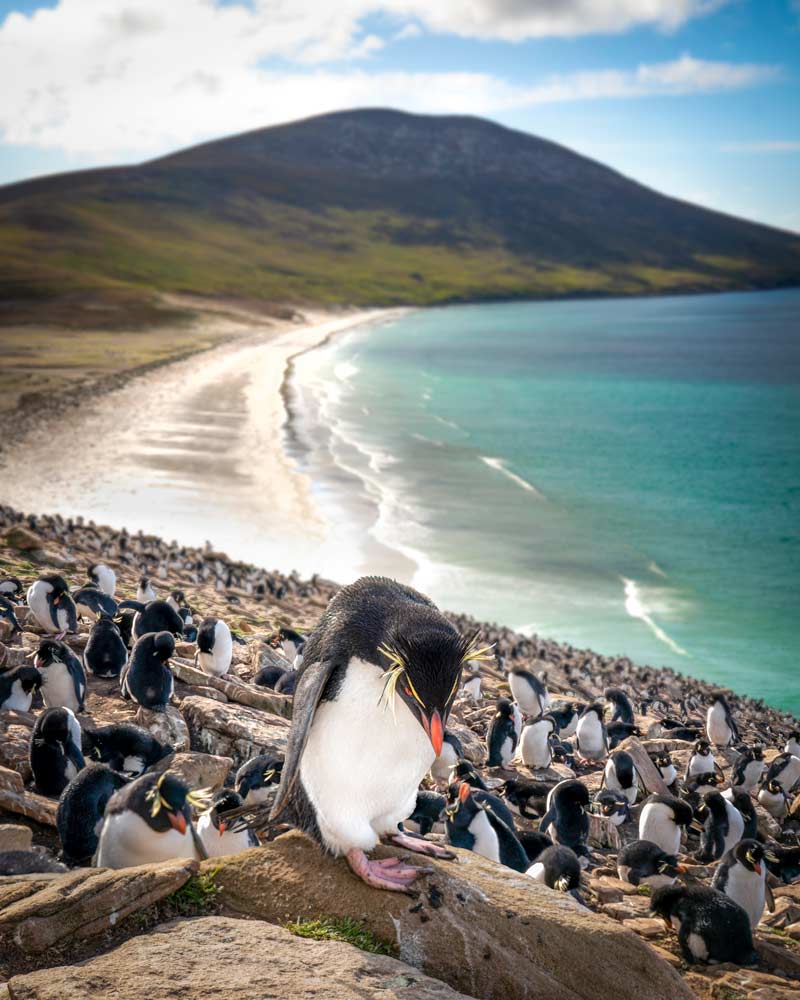
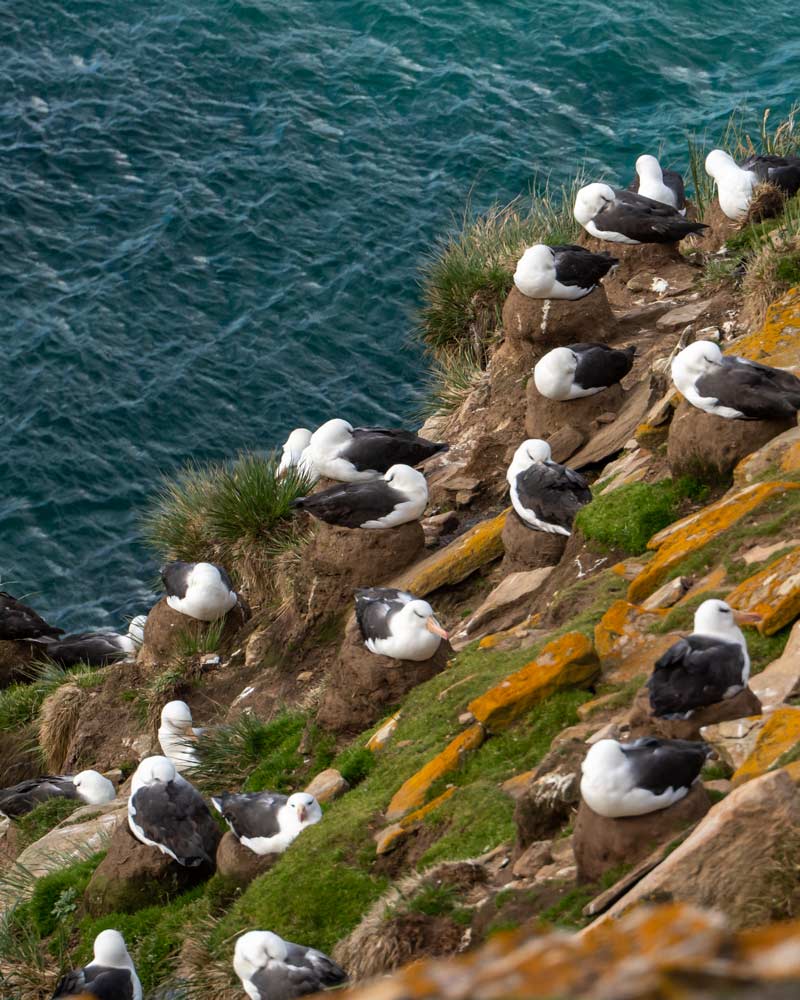
Accommodation at The Neck is basic: an old army cabin converted into two bedrooms, each with four beds in bunk style, one shower room, and a little kitchen lounge powered by solar and a generator. A WiFi hotspot surprisingly glowed in the corner, while a walkie–talkie–style radio was our only connection with the outside world.
‘Call me on this about eight pm, then I can tell you tomorrow’s flight plan’, Sue said before slipping out the door and driving back the way she came. It was just me, the friendly couple, and a solid set of penguin colonies. After a quick coffee and chat, I set about making up my bed.
On the one hand, you could look at this as the most expensive and basic hostel in the world, with rates of about £80 a night to sleep in a four-bed dorm if it had been full. But for me, this was the best value bunk I’d slept in. Return off-road transfers from door to door, million-dollar views out the window, and the chance just to sit and watch the penguins for hours and hours. Prices in The Falklands aren’t just for a bed, they are for the experience and the remote way of life, and for this experience, in all honesty, I’d have paid the same for a wind-battered tent, which unsurprisingly is an available, but not often taken up option.
I’m not good enough with words to summarise my time in The Neck, but it was one of the best days in my life, and to be honest, I’d have travelled all this way just for that. I was meant to have another night on Saunders Island so that I could have stayed at their other self–catering option at The Rookery, too, but I didn’t care that it hadn’t come to be – those 18 hours were pure bliss.
You barely had to move a hundred metres from the hut to be amongst the various types of penguins here. King penguins and their babies were on one beach, Rockhopper Penguins on the cliffs, and Gentoo Penguins bathed in the waters or minded their eggs in the battling winds.
The strangest thing to me is it was just me and the penguins. It was like being locked inside a Zoo. You have to know how to behave and respect the limits and wildlife code, but beyond that, time is no obstacle here. If you want to sit for hours and wait for an egg to hatch, go for it. You want to walk along cliff edges hunting out albatrosses, of which a considerable colony was close by, crack on. It really didn’t feel real.
As the sun started to set and the sky turned purple, I reluctantly said goodbye to all my new penguin friends and reheated my lasagne in the small oven. I fell asleep grinning, eager for a beautiful sunrise and my penguin fun in the morning.
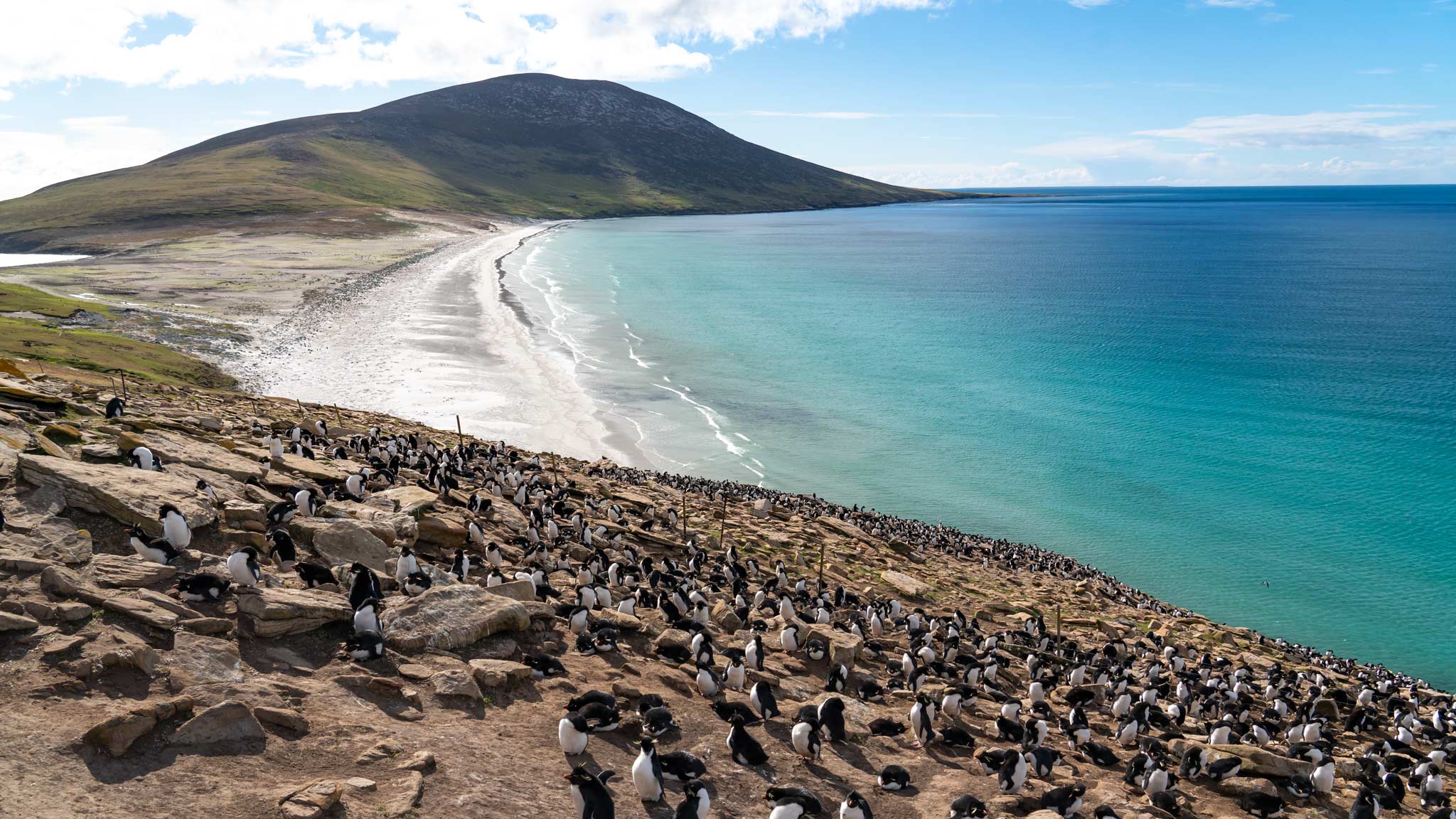
Day three – Saunders Island to Weddell Island
As the first light broke through the grey sky, I put the kettle on to boil and downed a coffee with a yawn. Sunrise didn’t look like it was going to happen, but as a sheep randomly popped up at the window, I took that as advice to wrap up warm and still brave the elements.
I walked down to the beach, where the sand was flying in the wind, and as if by magic, the sky started to turn orange as a rainbow appeared in the distance. Dutifully, a few pairs of King Penguins and their little ones started calling out on the beach, and I sat for what felt like an eternity, my mouth wide open, snapping photos and realising just how special a moment this truly was.
Was this the best day of my travels yet? It could well have been!
Shortly after, David pulled up in the jeep to take me back to the ‘airport’ – with a smile on my face and plenty more gate opening and closing, we chatted more about life on the island, tourism and fishing, of which fishing rights are a significant source of income for the islands.
As I waited for my FIGAS flight onto Weddell Island, I walked around the farm, and sheep scurried after me, occasionally trying to nibble on my trousers. As the call came in on the radio, the windsock was raised, the fire truck attached, and the small plane came into view before settling down just metres from us. From our 4WD, David operated the radio, talking to the pilot about wind speeds and directions, and I was amazed at the simplicity of the setup that served these people so well.
By now, I had lost all sense of time, but on landing at Weddell Island some 30–minutes later, it was only 10 am. Baffled at how this could be after what seemed like days spent with rainbow-bathed penguins, I was warmly greeted by my new hosts, Robert and Elaine, the caretakers of this vast island.
The tourism website said of Weddell Island: ‘The only settlement is home to just two human occupants, so you will make a significant increase to the population on your arrival’ – I guess I’d just become acquainted with said two human occupants.
This is, in part, what contributed to one of the most unique things about my time on the Falkland Islands, which was by the end of the trip, I knew everyone’s name. Every guest of where I had stayed, every owner, chef or waiter – even the names of the sheep shearers on the farm. Friendliness and reliance on others are a way of life here, and it was special to experience that first-hand.
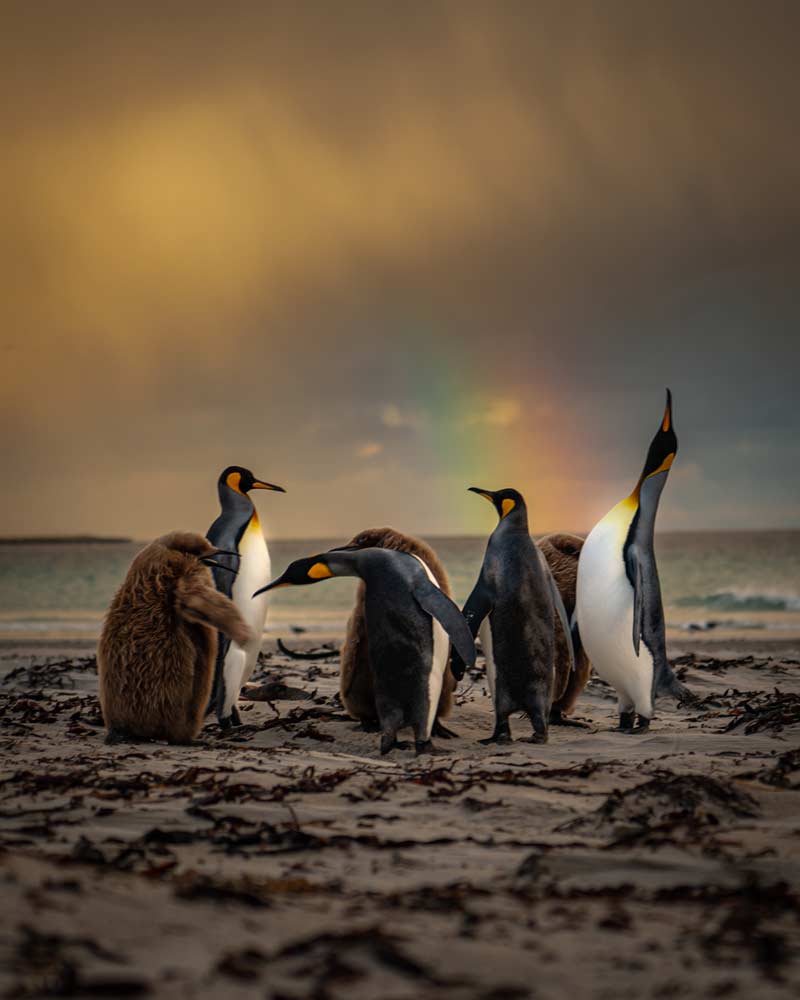
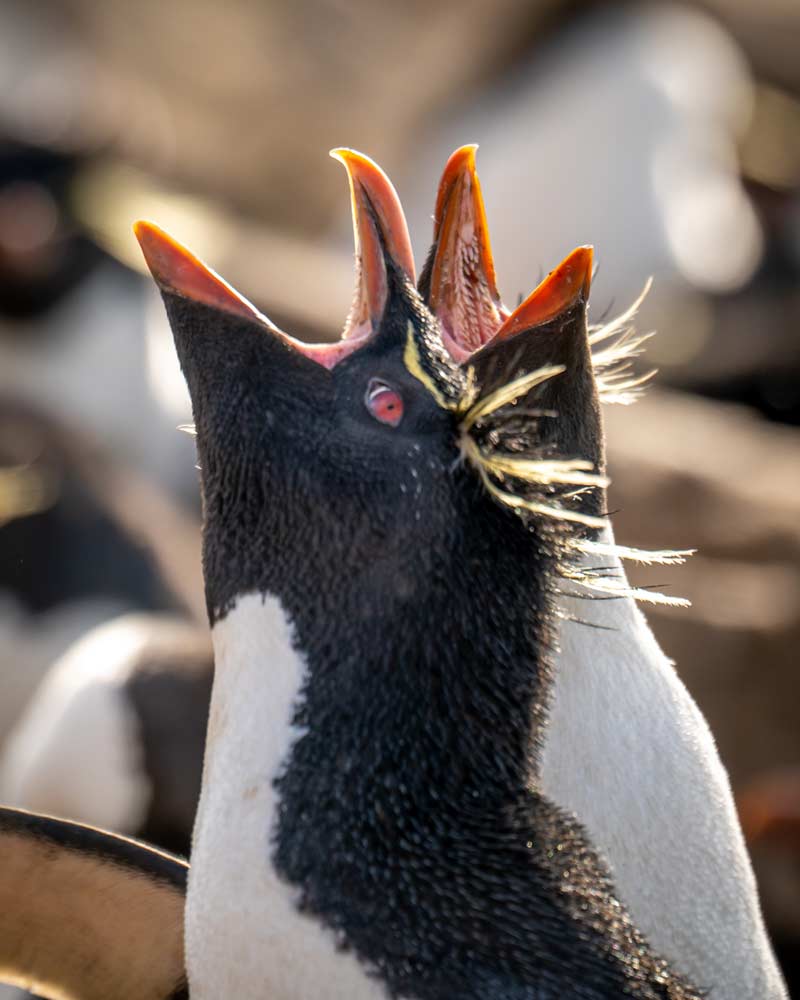
With so much of the day remaining, Robert gave me a lift up the ‘road’ to The Loop, a beautiful pointy stretch of the island with a rocky and green interior, surrounded by bright white sands and lapping waves.
‘I’ll pick you up in a few hours’, Robert said as I jumped out of the jeep. As he drove off into the distance, I realised it was just me. Me and hundreds of sheep, the sly ones that had escaped the shearing season back on the farm.
No phone signal, no person in sight or sound, and still no trees when you needed the toilet. I settled onto a beautiful beach and feasted on my packed lunch. Wagon Wheels, cheese sandwiches, homemade cakes, you’d never go hungry with a Falkland Islands-packed lunch, that’s for sure.
I strolled along the beaches as penguins dived in and out of the water, started talking to sheep and wondering if I would be slightly crazy by the end of the two weeks, and tried to find one of the Patagonian Grey Foxes, which had been introduced to the island many years, to no avail.
With a short while left until Robert (I hoped) would return to get me, I sat and admired the penguins on the beach from afar. This was special. When was the last time this particular beach had seen human footprints I pondered? How was I so far away and so disconnected from the world as I knew it? How long had I been on these islands?
Time is a constraint that seems to be defined by the sun rising and setting here and relatively religious times for meals. But beyond that, it disappears as a visitor. As a jeep appeared in the distance, I returned to the farm. Weddell Island is the size of the UK city Birmingham, which made the full-time population of two even more mind-blowing.
Leaving my boots outside and discarding my many layers, the warm house and a cup of tea was a blessing. ‘Usually, we set up the guests in here and serve you dinner,’ Elaine said as I poured a second cup in the kitchen, ‘But as you’re the only guest, how about you join us and the shearers family-style’?
Happy for the company and invited into the family, we all dished up on the one table, chatting about our days and laughing all around. I went back to my very cosy bedroom with a smile on my face and caught the last rays of light from the wide windows, framing the mountain, sea and bright yellow gorse around the farm like a perfect postcard image.
When you book a room in the Falkland Islands, especially outside of the main town and in ‘camp’ as the locals call it, it’s not just a room you’re getting. Your meals are included, transfer from the ‘airports/grassy strip’, and luckily, it appeared a friendly company to share meals, chats and coffee with.
Oh, and Smoko, the islanders’ tradition of lashings of cakes, often left out all day to help yourself too.
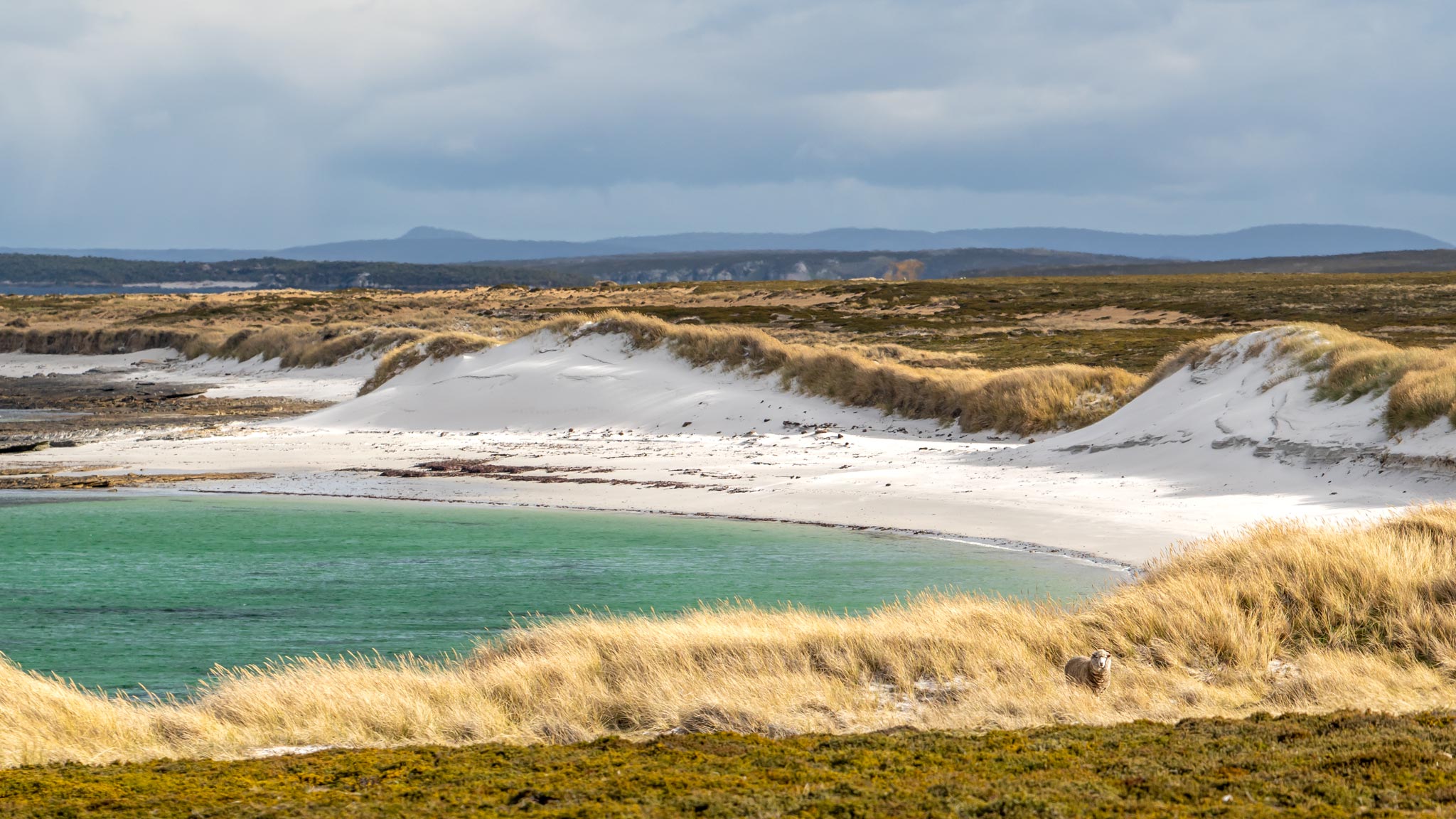
Day four – Weddell Island
Rising bright and early, I headed down to the kitchen and poured myself a coffee. Elaine was preparing breakfast, and we had a good chat about Island life. We joked about there being no Sainsbury’s around the corner and how bad Elaine felt when someone with dietary requirements arrived with no advance notice and tried to create a meal with what was in the pantry.
It’s those little details, like not needing to order your food by plane or monthly shipping boat, that you don’t think of in a holiday destination. But the Falkland Islands way of life was slowly consuming me, and the outside world had firmly slipped away.
Internet does exist here, but at £5 for a 50–minute data card that sometimes barely worked, it was an investment I was happy to ignore and be more present. Already, I’d read books, dived into my own thoughts, and slept better than at home. Not being glued to a screen undoubtedly played a big part in that.
Wrapping up warm, as the wind was still fierce, I spent the rest of the day strolling around the island. There was a mountain, where I was told a box of biscuits awaited at the top and a book to sign, as so few people had reached the peak, but I opted to stay at ground level, wandering through fields of sheep, beaches of penguins, and taking in the beautiful vistas.
At one point, I tried to send my drone up, and it disappeared 30-odd metres sideways before I was even ready with the controls. It never made another flight again in the trip, scaring me enough not to trust my flying capabilities.
A lot of my two weeks in the Falkland Islands was spent not doing much at all, sitting and admiring the wildlife, wildly grinning in disbelief, settling into a slower pace of life is all part of the attraction here, different from a city–break that is for sure.
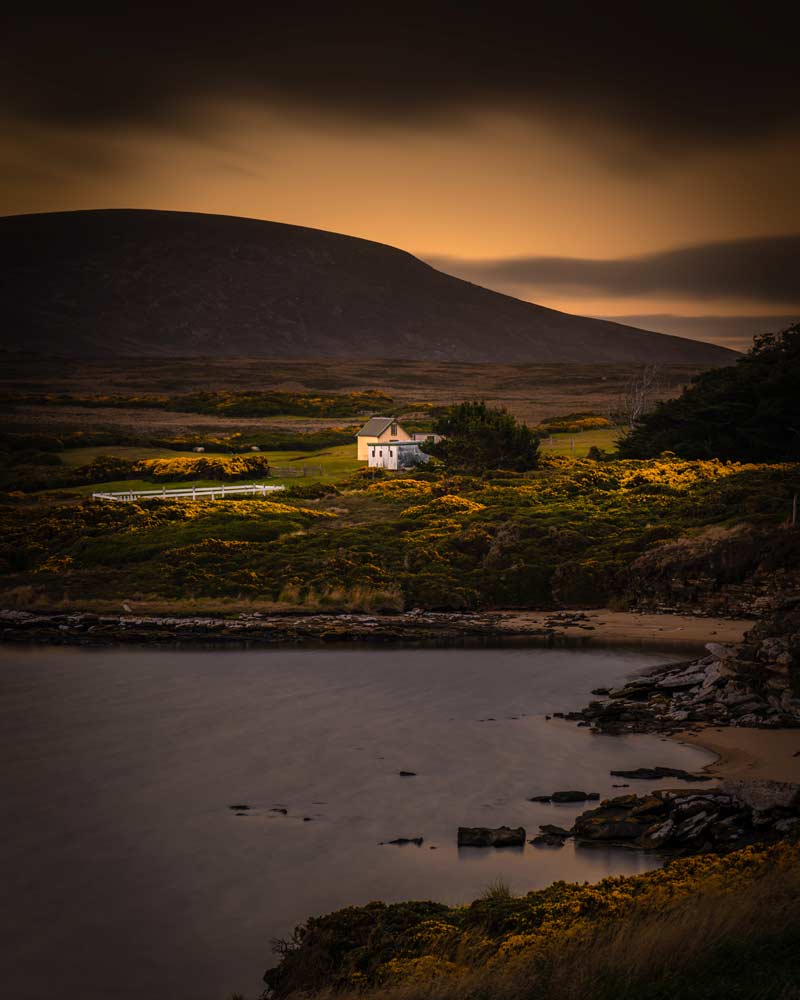
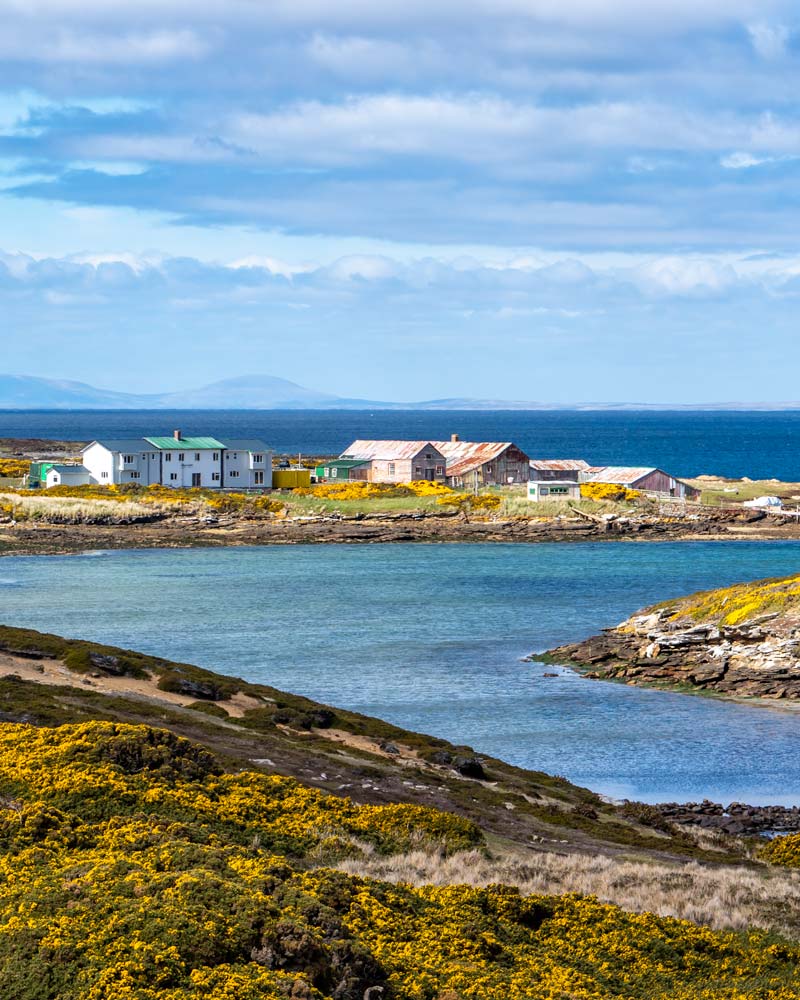
As the sunset and dinner time approached, I headed back to the farm where Elaine told me my flight would be midday tomorrow rather than the morning flight I’d imagined. I’d heard of people who try to do only a day in each place and how flying schedules and wind had thwarted their plans, so trying to rush the Falkland Islands clearly wasn’t a safe bet.
As we settled in for dinner again, the shearers looked exhausted from their long day, and with thousands upon thousands of sheep here, I didn’t blame them. I took the time to ask all the questions I had about life on the islands, such as how schools worked and doctors. In the most significant settlements, small schools existed, for the more remote islands, education by telephone and homeschooling was supplemented by occasional in–school lessons, while at a certain age a type of boarding school in Stanley become the option. For University and post-sixteen education, the only option was heading to the UK, likewise for some more serious medical procedures.
I thought back to that gruelling 19–hour flight and shuddered, not the journey you’d want to take if you had a severe ailment!
Whether it was the harsh winds, the sun that was somehow burning the rare parts of my body not covered, or just being on island time, I was exhausted and passed out as soon as I’d settled into bed.
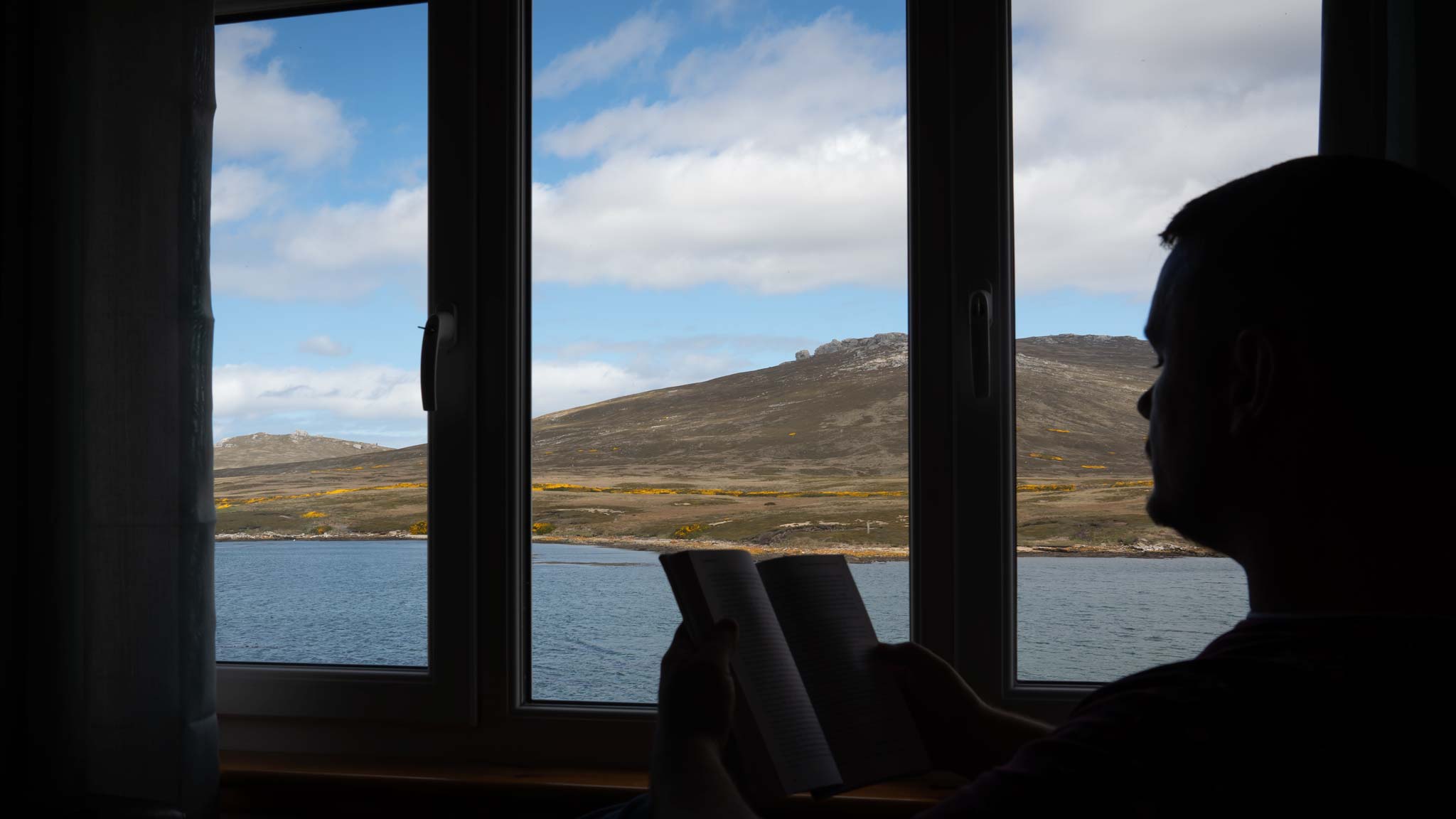
Day five – Weddell Island to Port Howard
The mist had consumed the farm by morning, and the phone rang out at 8 am sharp as I was eating my breakfast, which was similar to the UK but with the option of lamb chops.
Robert gave the weather vitals to the caller, acting as the local weather station, and told me my flight would likely be delayed. With the weather, there wasn’t a safe flight path, so I happily relaxed on the sofa by the window and stuck into my book. By lunch, the news still wasn’t looking good, and another night on Weddell Island seemed to be the solution.
Another call came, this time saying the flight was leaving Stanley and to be on standby. As we pulled up to the landing strip, with the pilot chatting to us over the radio, we drove up and down, honking the horn to send the sheep off the runway. The windsock went up, the high–vis was donned, and the fire truck attached. From the white misty skies, the small plane appeared, and I hugged and said goodbye to my hosts. It felt like I was leaving family members, and I couldn’t believe three days ago, they were strangers.
This flight didn’t have the beautiful views and calmness of the previous two. We flew low, barely off the water, before hitting a white cloud and not being able to see anything outside. I’m a pretty confident flyer, but I found myself almost saying a little prayer. Suddenly, a clearing appeared in the clouds, and our expert pilot, Dan, went for it. The wind felt like it was going to pummel us into a mountain, and I concentrated on what looked like a whale down below. I’ve never been so glad to see a windsock before in my life, and as we touched down, I think it’s fair to say we all took a sigh of relief, except maybe not the pilot, who looked calm as day – a testament to the conditions these islands bring throughout the seasons.
I’ve never been one to clap the pilot on landing, but if there was ever a time for it this was it, had it not just been four of us I might have started the chorus.
By now, it was fairly late in the day, and Wayne from Port Howard Lodge was waiting to drive me and the one other guest on my flight to Port Howard Lodge, where we were greeted by his wife, Sue, with the offer of a warm cup of tea.
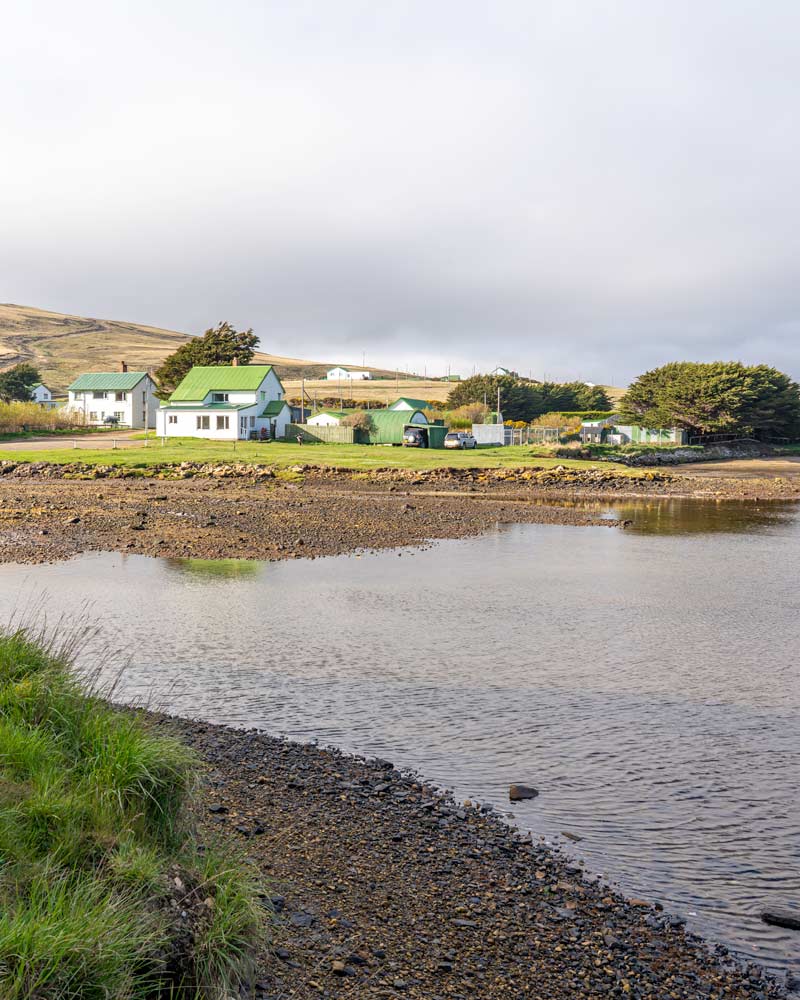
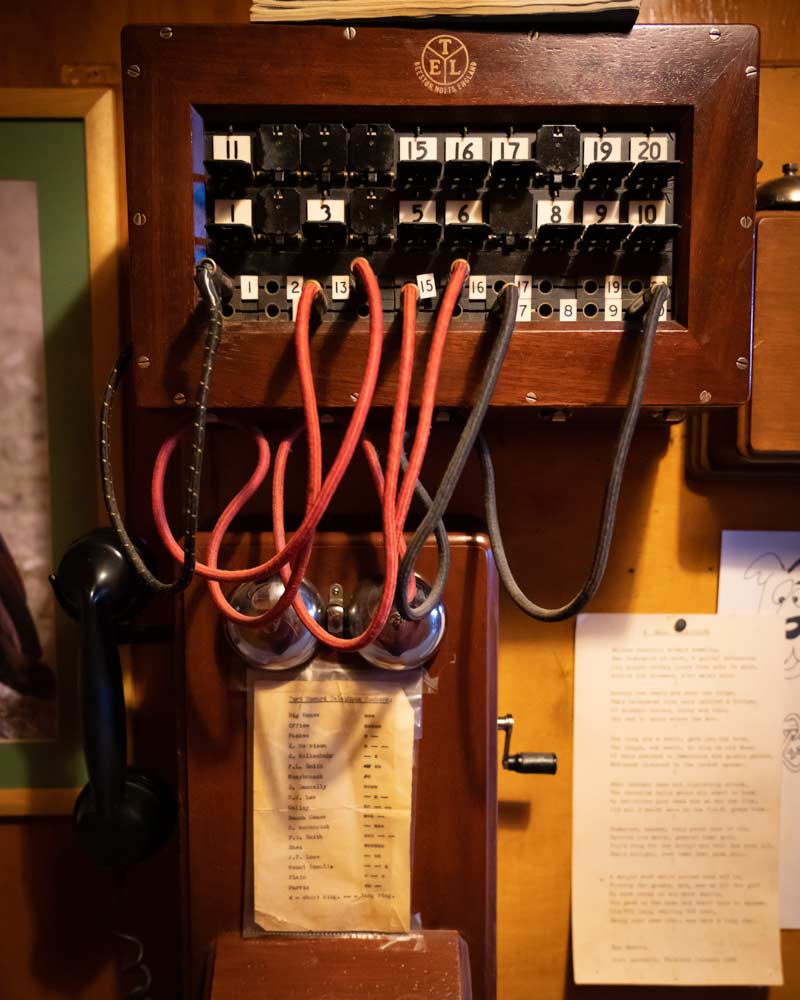
Port Howard Lodge felt like stepping back in time even further, thanks to the historical collection of artefacts around the home. An old original telephone system was on the dark wood panelling in the hallway, while fishing gear and war artefacts adorned tables and picture frames. In the garden, a small war museum of objects and items found on West Falkland had been curated by Wayne, including uniformed and firearms.
Travelling in the Falkland Islands is very DIY and self-reliant; there aren’t always lists of things to do and see or structured guides in the lodges, and Port Howard was one of those. It wasn’t until after I’d left that I learned about the pods of dolphins that would dance along with the ferries at the nearby port, which is a shame as I’d have loved to witness that. Instead, you need to be quite sure of what you want to do and do your research before arrival, as the internet can be limited or not working at all, as was the case here.
Strolling around Port Howard, it seemed like a megacity compared to my previous two stops. There was a small school, cats, pigs and cows, and even some trees. It’s incredible how these normal things suddenly seemed so bizarre after nearly a week on the Falkland Islands. There was even a small general store in Port Howard, and although I could see the shelves lined with booze, cereal and other goodies, it only opened between 4–5 pm on Mondays, Wednesdays and Fridays, so my shopping spree was not meant to be.
Heading back to the lodge a couple drove past and say hello from the window, a bit taken back, I struggled much more than a wave back. The jeep continued onto their farm, as from what I had seen, most of the Falkland Islands was a giant farm.
Dinners at 7:30 pm on the dot had become the norm, and I was grateful to have company this evening to spend it in the form of a fellow traveller. We settled in for a three-course dinner served up at Port Howard Lodge and shared our plans while here.
Tired from a long day of not doing much at all, I took a whiskey from the honesty bar, jotting down my beverage on a small notepad to settle on checkout, and headed outside to watch the full moon. For much of my trip, the night skies had been cloudy, making astrophotography hard, but tonight, the brightness of the moon had broken through a small clearing. Back in my room, a basic affair which reminded me of my old grans’ house, I passed out quickly.
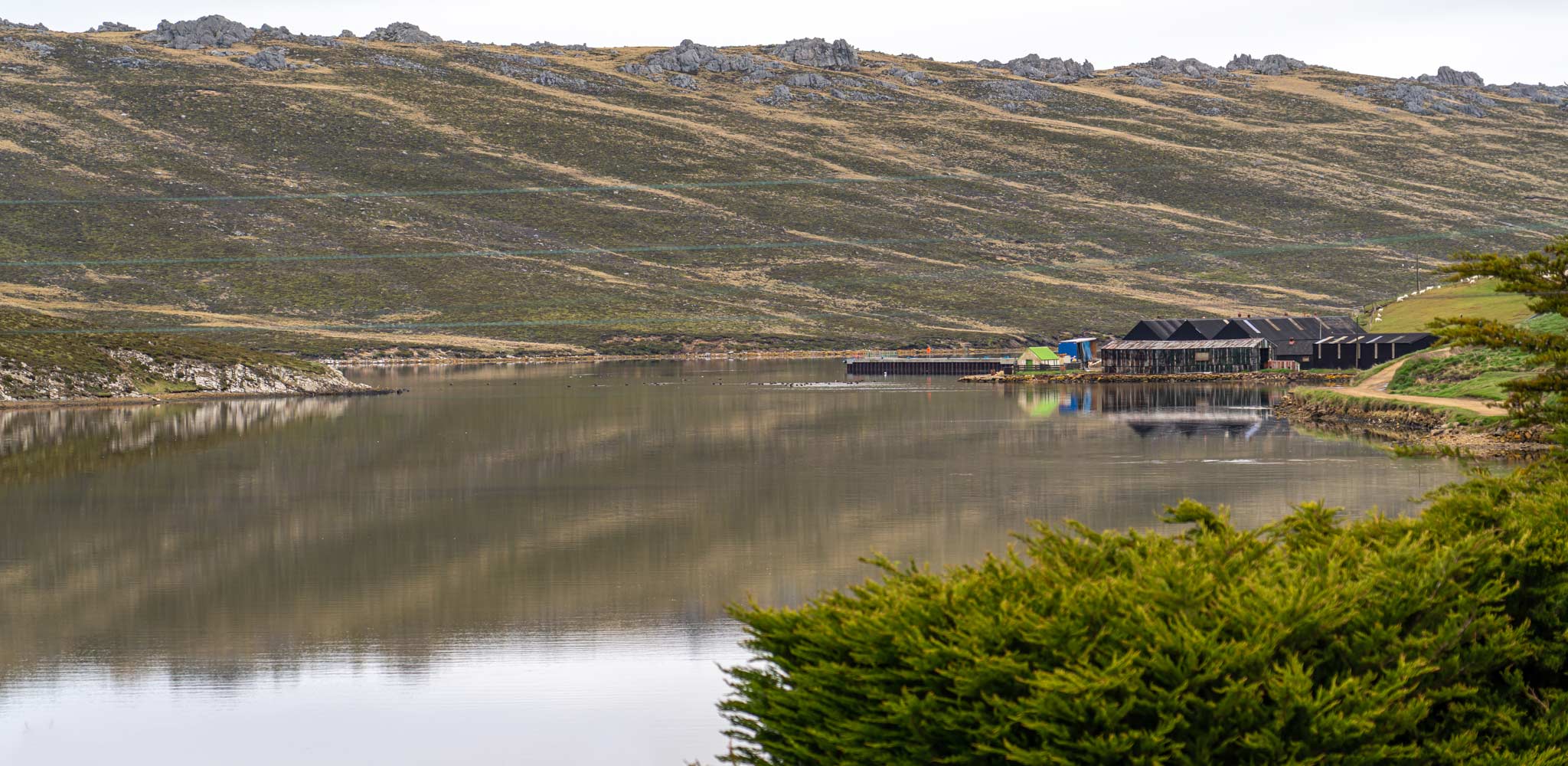
Day six – Port Howard
Breakfast was served sharp, a full fry-up that was sure to clog the arteries before I headed out on a day tour with Wayne. Although you can hire cars on East Falkland, on West Falkland, car hire is banned due to the shortage of proper roads and previous problems with people getting bogged or damaging the vehicles.
Many people venture to Port Howard for trout fishing, which is apparently at its prime here, or to hike up the hills and third highest mountain of the Falkland Islands, Mount Adam, which sits just shy of the settlement. You can, of course, access wildlife such as penguins here, around an hour or two away off-road, but given I’d been spoilt with penguins so far, I was keen to see more of Falkland Island life on my day out with Wayne.
We pass the debris of a plane on the side of the road, and Wayne tells me that the Argentinian pilot had survived and had come to stay and see the site of the crash a few years previously.
Continuing on the one main all-weather track of East Falkland, we pass a campsite, which strikes me as peculiar, partly due to the weather, but also, without rental cars, how the hell do you get out there?
Apparently, camping on the Falkland Islands isn’t usually a problem, as long as you’ve checked with the farm owner first. At Patricia Luxton Nature Reserve, the camping site even has a portaloo, and although Wayne told me of a group of mountain bikers he knew had explored that way, he admitted camping wasn’t so popular as transport options make it hard. Wayne said he hoped to get some mountain bikes, or maybe even quads, out here in the future, which I think would make it a much more fun and adventure-loving stop.
Just beyond the nature reserve, which also struck me as odd, seeing as all the Falkland Islands are basically a nature reserve, we arrive at a vast lake to try and spot Black-Necked Swans. In the distance, a few of them are gracefully floating around the lake. I questioned the receding waterline and heard about how water levels are decreasing here. The change in environment was affecting even the far-flung corners of our world, and I remembered having spotted some plastic on remote beaches here, which, I assumed, had washed up, given the very few visitors that stretch of beach had ever seen.
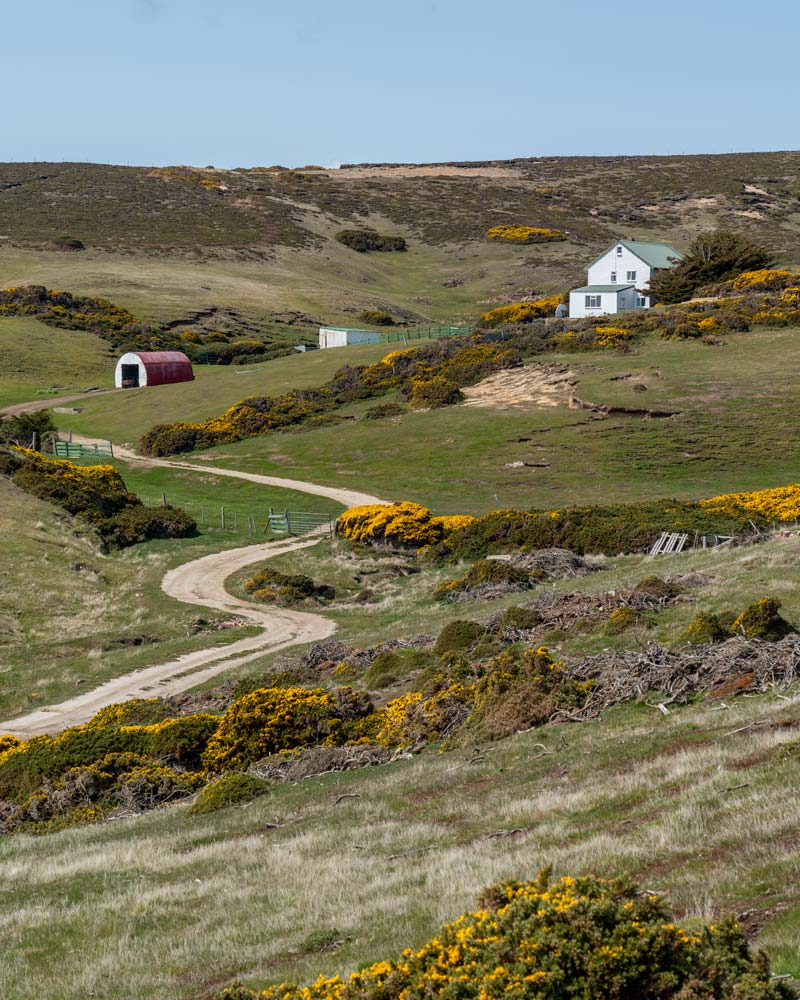
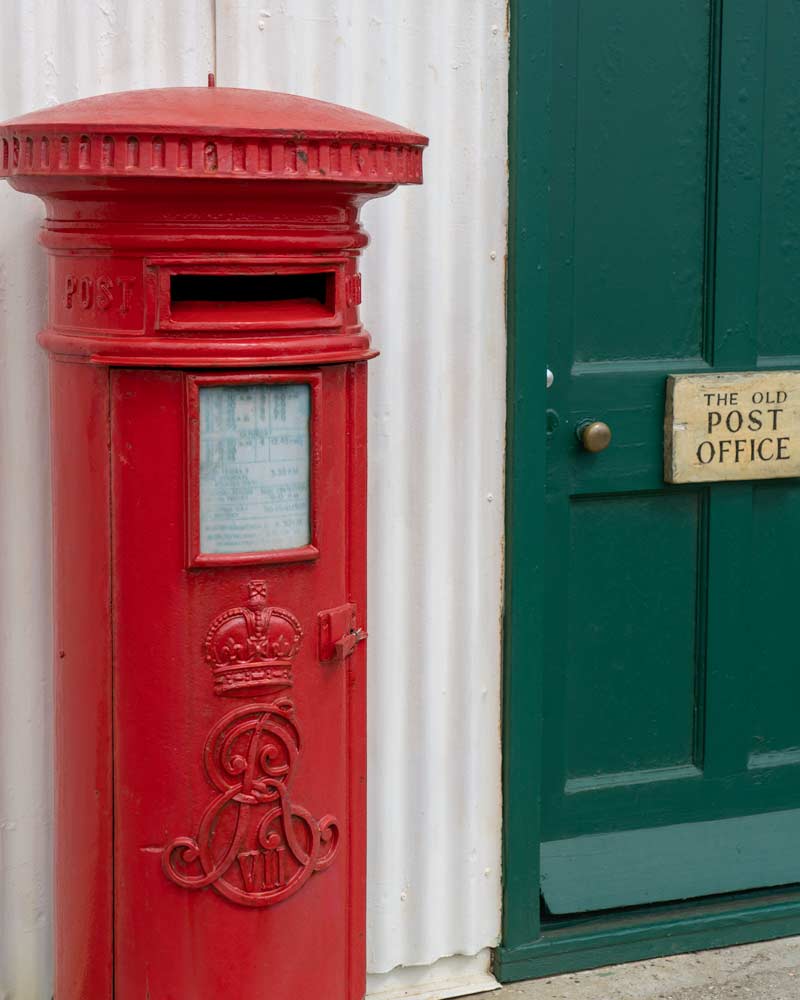
We head to Fox Bay, the second largest settlement of the Falkland Islands, where the old post office, now a museum, was the most interesting attraction. It was a bleak day, and the bright red British postbox added a spot of colour. The museum was closed, and I wandered around the small settlement, where fuel tanks somewhat ruined the views of nature I had become so accustomed to. A small war memorial stood on the corner of the land, and in the distance, penguins climbed in and out of the water.
Our next stop was Hill Cove, home to the Falkland Islands’ only ‘forest’, although this small collection of trees would have been anything but a forest anywhere else in the world. Another landing strip and accommodation lodge can be found here, and I explored the abandoned working sheds, where old, slightly rusty machines were slowly being reclaimed by nature.
The sun had risen, and the waters were glistening in all their glory again. The weather very much defines the landscapes of the islands, I realise, as the wild, empty terrains could look glum and dismal in grey but vibrant and fascinating under the sunlight.
Arriving at Roy Cove, the final settlement on our day trip, I took a wander down to the jetty in hopes of seeing some seals or dolphins, but sadly, none were forthcoming. Although I had Wayne for the company on our drive, and I enjoyed learning more about life on the Falkland Islands, especially from someone who had moved here and wasn’t born here, I was starting to feel pangs of loneliness. I’ve travelled a lot solo, and I think the Falkland Islands are certainly somewhere best shared with a travel buddy.
Roy Cove was by far the prettiest stop of the day, more so than Port Howard; with its water inlets, white buildings, and the yellow gorse bushes in full bloom, it was a pretty little settlement with a few farms and outhouses. Quite a few places I saw throughout the day were abandoned, although they surely did have owners – many of whom I was told would return during shearing season.
With my fellow traveller gone, dinner was me and myself. As I ploughed into a hearty plate of spaghetti, I think it’s fair to say I was starting to miss things from home, especially friends and people. You really are cut off from the world out here, especially with the internet costs, or it’s not even working. I chatted with Wayne and Sue briefly after dinner before heading up to pack for my departure in the morning.
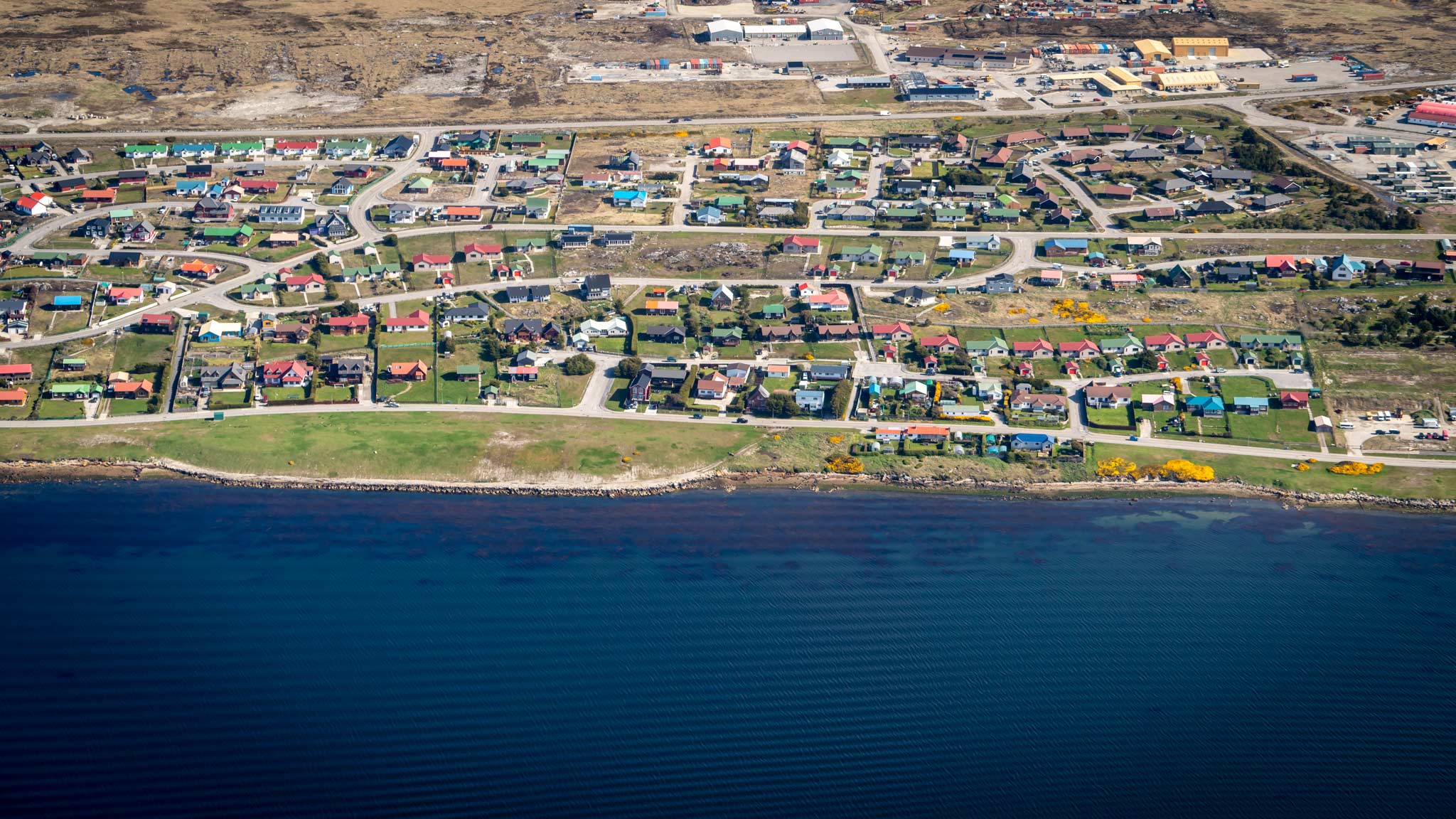
Day seven – Port Howard to Stanley
With the morning fry-up came misty views, mist so dense in fact that Sue said she was concerned about the flights as she gazed out of the dining room windows. I put a tiny drop of ketchup on my plate, concerned that it cost nearly £5 a bottle here and not wanting to use too much, and prayed the flight would come. Although I’d have happily spent another day on Weddell Island, Port Howard didn’t enthral me as much as my previous stops.
Weather reports were called in, and flight updates came back and forth. As with last time, it wasn’t going ahead, but as the mist cleared and an opening appeared, confirmation came in that the plane could make it to the closer landing strip than the one I had arrived into.
After a couple of stops at some other islands, each one looking beautiful in its own way, we touched down at Stanley Airport. The smooth tarmac surface and little building welcomed me back to civilisation, and suddenly, Stanley seemed huge compared to when I’d briefly passed through on arrival. With her welcoming grin, Tina picked me up, and we chatted all the way into town – a conversation I was so happy and excited to have!
For the next week, I’d be staying in Stanley, which I imagine isn’t too common. Most of the visitors to the Falkland Islands would spend much of their time on the outlying Islands, but I had plenty of day trips planned from here and was intrigued to see the day-to-day life of the capital.
Arlette gave me the warmest welcome as I arrived at her beautiful Lafone Guest House. My double room at the front of the house looked straight out onto the inlet of water leading into the city, and the bed was as comfy as they get. The large lounge area downstairs had plush sofas and plenty of books, and the heating was turned right up. I was pretty smitten with my home for the next week, and that was before I’d even tried Arlette’s famed cooking!
After getting settled in I took a short walk around Stanley, although I’m not sure you really could take a long walk around Stanley, it was less than an hours stroll from one side to the other. Given the size of the capital, there are still a fair few accommodation and dining options and enough pubs for a few sessions. I popped into Shorties Diner on Tina’s recommendation of quick and easy food and spent an unfathomable amount of time staring at the menu. After a week of having my meals served up and them being whatever they would be, this world of options and choices seemed baffling.
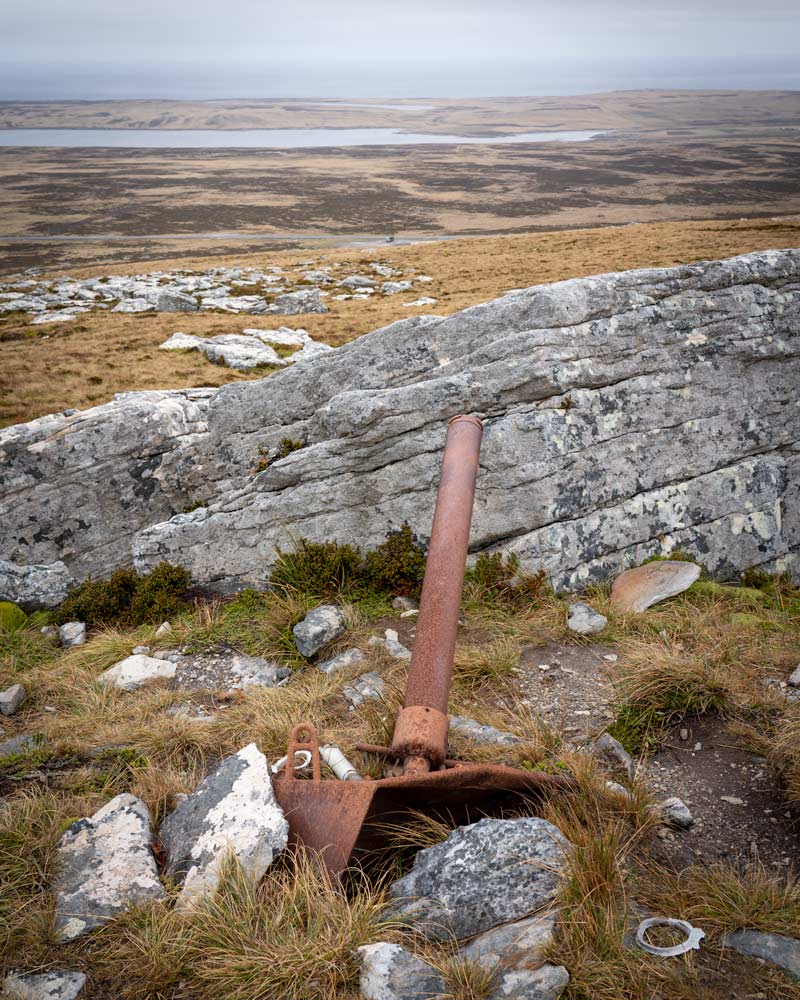
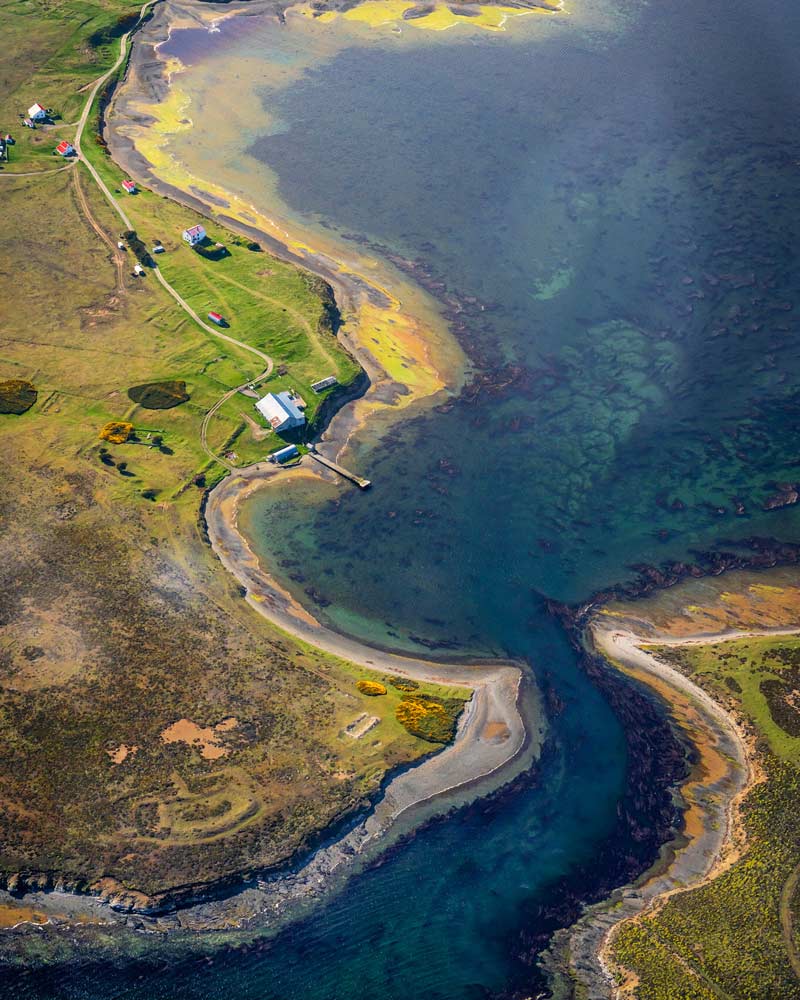
Day eight – Stanley Battlefield Tour and Helicopter to Volunteer Point
Shit! My clock told me it had gone 9 am, my pick-up time, and in an insane panic, I quickly dressed, packed a bag and rushed downstairs. No one was around, and I couldn’t believe how I’d managed to sleep in, given how early I’d risen every other day. Damn, that bed must be really comfortable.
Popping on the kettle for a coffee, at a loss of what else to do, I realised the clock on the oven said 5 am. Slowly I realised I’d grabbed my work phone which I hadn’t update the time on. I wasn’t late at all, I was working on UK time, and was in fact stupidly early.
Feeling dumb, I took my coffee outside into the mist and enjoyed Stanley’s silence at this time in the morning. By the time I came back inside, the house was awash with laughter and conversation. Taking my place at the breakfast table, where we all sat family-style, I shared breakfast with an Argentinian family who was vacationing here.
After swapping out my dirty laundry for a packed lunch from Arlette, who kindly offered to do my washing for me, Tony Smith from Discovery Falklands picked me up for my Battlefield Tour.
I’ve got to be honest: while I know the war was a defining part of the Falkland Islands’ history, and I’d read up on it intently before my travels, this was part of my itinerary I wasn’t particularly looking forward to. Luckily, Tony, somewhat of a local legend, made it much more interesting than I could ever imagine.
For a more in-depth history of the conflict, I’ll let you search online, but as we drove through the mountains where the final stages of the war had been thought, we went past helicopter parts and weaponry, stopping at key spots. The most haunting part of the tour, apart from the stories, is how untouched much of this land is. While most of the de-mining operation is now complete, the other debris of the war remains very much untouched.
Climbing up mountains, we stepped over uniforms, shoes, communication wires, ammunition and many other reminders of what had been witnessed on these mountains. This was all heightened by Tony’s stories, both from the factual information of how the war had unfolded to his personal stories of being a young lad living on the islands during the conflict. In the distance, we saw army personnel from the military base also hiking the mountain, and in the mist, I could almost imagine the stories in real-time.
While the weather had stayed gloomy and grey for much of the morning, adding to the dramatic scenes, by the time we arrived at the final spot, the sun arrived and lifted my spirits, also helped by Arlette’s treat of a packed lunch. I was glad for the blue skies, not just to lift the mood but also as my helicopter tour was dependent on the weather. Luckily, it was a go!
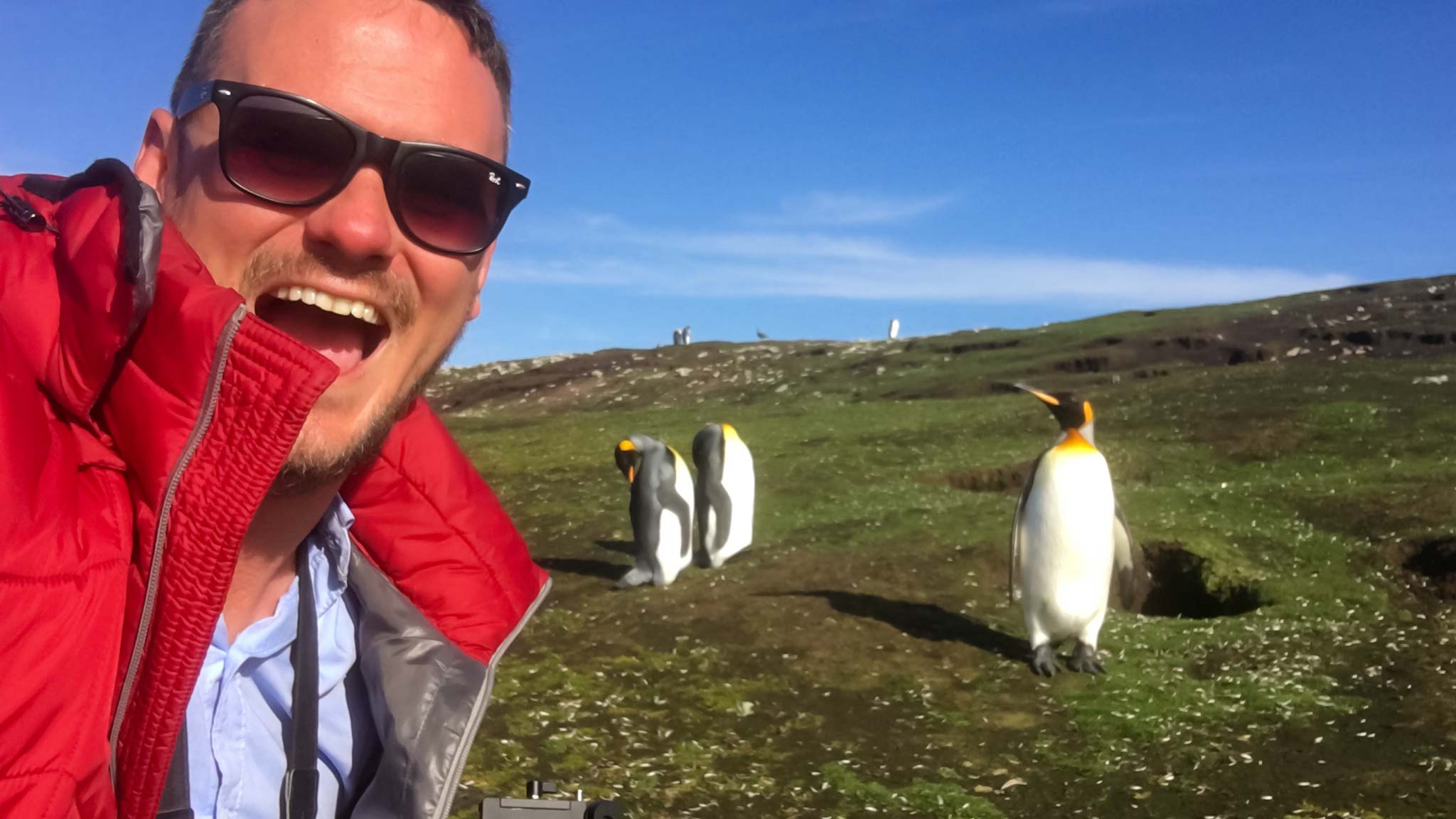
My now favourite familiar smiling face, Tina, was waiting for me at Stanley airport as I jumped out of Tony’s jeep. The Falklands Helicopter Service was a new addition to the island and was offering scenic flights and half-day trips to popular points. Today, we were off to Volunteer Point, one of the most famous destinations for visitors here.
Almost unbelievably, cruise ships arrive in Stanley at an ever-increasing amount, and I don’t just mean small exploration vessels. While recent figures show around 2000 overnight visitors a year, the ships bring in around 40,000 visitors annually, and when big ships arrive, everyone in the capital with a vehicle basically becomes a driver, usually to ferry people on the off-road track out to Volunteer Point, where a king penguin colony lives. The helicopter not only shaves the two-and-a-half-hour one-way journey down to about 30 minutes but also offers amazing views of the islands, such as the Lady Elizabeth shipwreck.
Boarding the tiny chopper, Tom, our pilot and one of my pilots from early in the trip, gives the three of us a small briefing. Being a small helicopter, each seat has window views, so none of that middle-seat drama, and we gracefully glided upwards into, thankfully, the best weather I’d seen yet during my visits.
Now, the aerial views of the Falkland Islands were impressive from the small FIGAS planes, but from the helicopter, they were something else. We flew over little settlements, deep rivers, shipwrecks and untouched beaches, and on both the outward and return flights, I was in complete awe. Bays with cerulean waters came to life from the air, and the grin on my face stayed for the entirety of both flights.
Arriving at Volunteer Point, a few sheep bound away, allowing us to land, and just beyond the beach, I can see hundreds, if not thousands, of King Penguins. Having seen so many at Saunders Island earlier in the week, I didn’t think I’d feel so giddy, but it turns out you can never have enough King Penguin encounters.
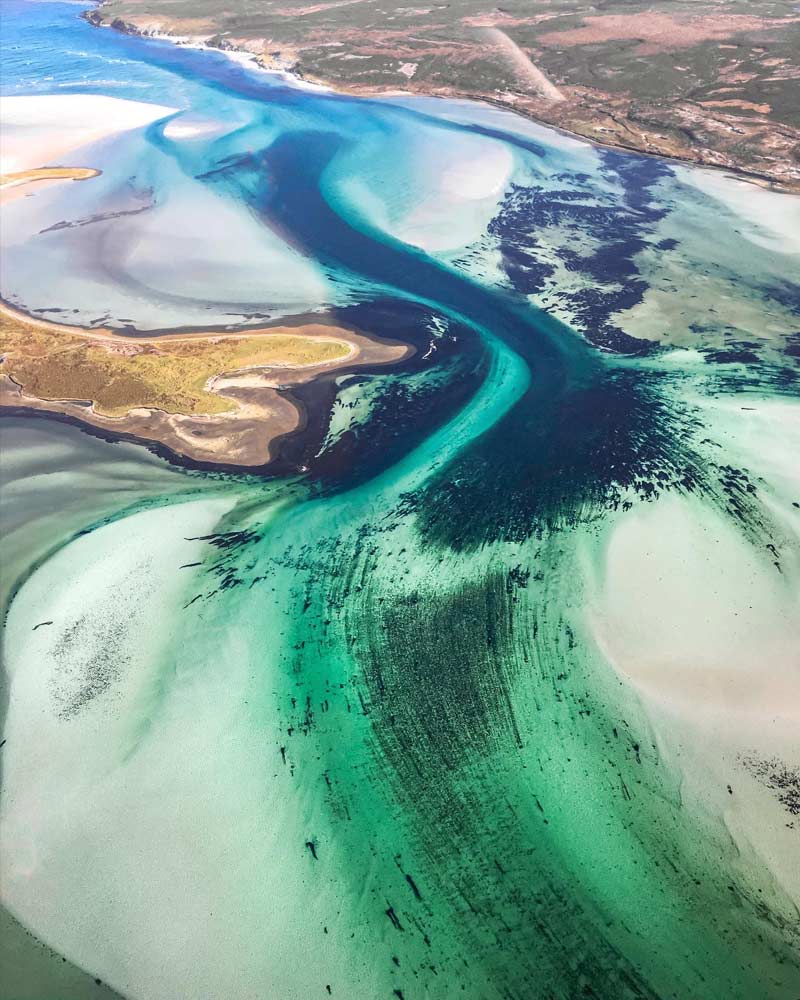
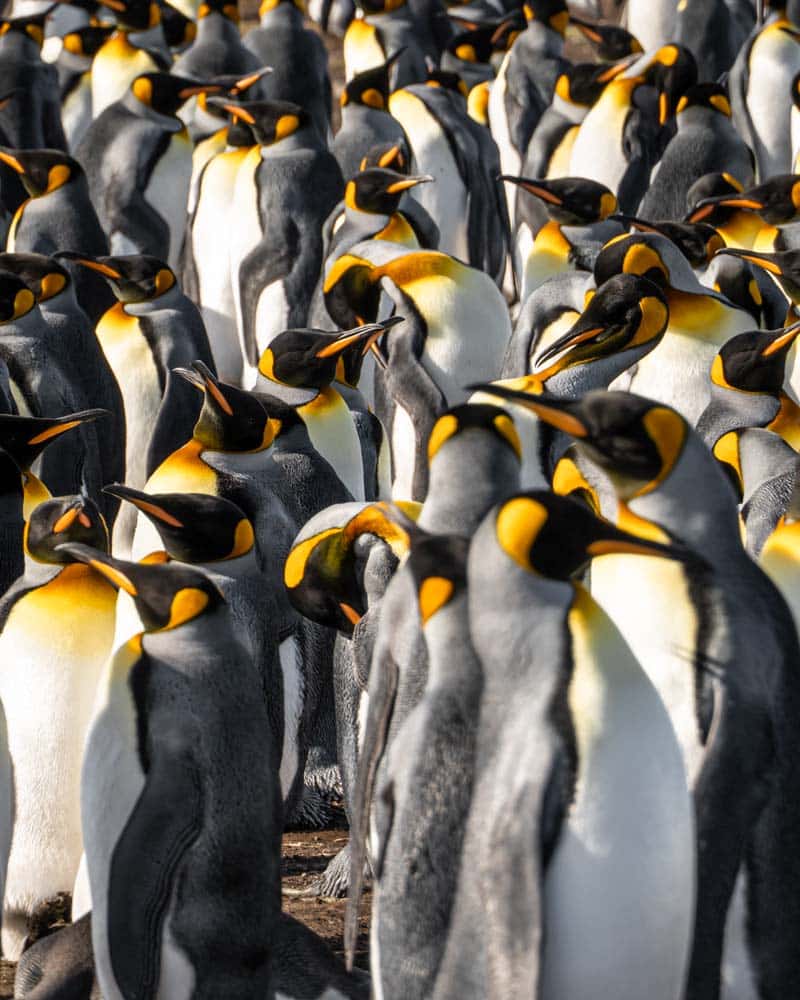
The vast area they called home was pretty much left to nature, except for a small set of toilets in a hut and the warden’s cabin. Carol, who I’d met on Saunders told me there a few beds at the wardens cottage you can rent, and it was here that she got her incredible sunset silhouette shots of the penguins, so do consider trying to spend the night here if you can.
There are clearly defined penguin and home zones here, and much more rope, which makes sense given this is where many of the cruise visitors would go and thus a greater need for tourism management. This afternoon, though, there were less than ten of us in total here, and although we stayed away from the cornered colony area, the penguins weren’t as good at abiding by the rules as we were. The fluffy babies, some with much of their fur now gone, especially enjoyed wandering up towards us to say hello. I don’t know enough about conservation to say if this is a good or a bad thing, but I imagine if tourism increases in the Falkland Islands, it will have to be a consideration, as it just takes a few badly behaved visitors to have an impact.
That afternoon was just pure joy, from the penguins waddling on the beach to the fantastic views of the helicopter flight. I’d have come to the Falkland Islands just for that moment, and although the helicopter tour might be too much for some, it seemed reasonably priced compared to others I’d taken in, say, Australia. Even if I’d had to embrace the long, bumpy drive here, though, I’d have done that instead. Genuinely, an unforgettable memory that will last a lifetime.
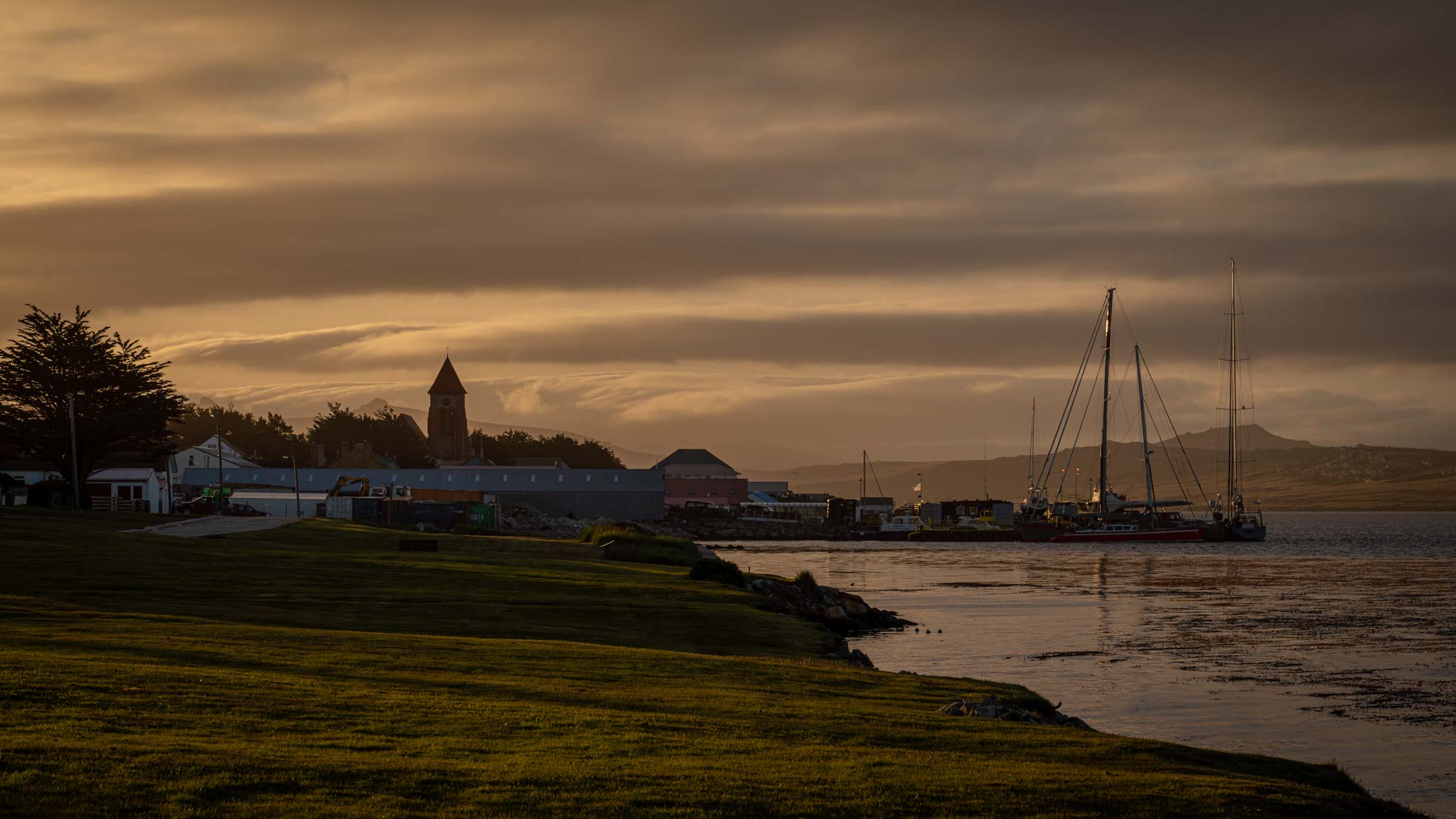
Day nine – Stanley
I woke up to gale-force winds pounding the windows and streets of Stanley, so much that it was an effort to walk in a straight line. Happily, I had no plans or tours for today, so I spent my day lazily reading books and wandering between the sites and coffee shops of the town.
There are a handful of places to see in the capital, such as the Whalebone Arch at the local church, the ‘resident’ seals on the jetty by the tours office, the HQ of Penguin News, the weekly newspaper of the islands, and the Falklands Museum, of which I spent a few hours in.
With outer houses showing the traditional way of life on the islands and a museum crammed with memorabilia and conservation information, it was interesting to visit. The most striking part of the museum was the film about the war, presented and voiced by those who were children during 1982, now adults. I recognised some of the names from conversations this past week, which gave me a chill, warmed up by a hot chocolate from the cafe opposite.
There was no sign of the gales dying down, so I headed back to Arlette’s for a cuppa, cake and an afternoon in bed with a good book.
Day ten – Exploring East Falkland with Falkland Outdoors
After some toast and a coffee with Arlette, which was now a morning routine I looked forward to, Dan from Falkland Outdoors came to pick me up. I was excited about the prospect of Sea Kayaking, but sadly, yesterday’s gale winds had made the weather unsuitable for hitting the waters.
Jumping into the jeep, Dan suggested some options we could do instead, and with the promise of penguins and Dolphins, we headed off to Bertha’s Beach.
Situated on Fitzroy Farm, the beach isn’t far from the Mount Pleasant Army Base, and thus, being on private land, we had to call into the farmhouse to collect the key en route. As with everything in the Falkland Islands, that came with a warm welcome and offerings of tea and cake.
While on the farm, we stopped for a moment of fishing to maybe catch some fresh lunch and sample the renowned local trout, a non-native species that had been introduced years ago. We didn’t have much lunch, but with Arlette’s huge packed lunch waiting for me, it was no biggie.
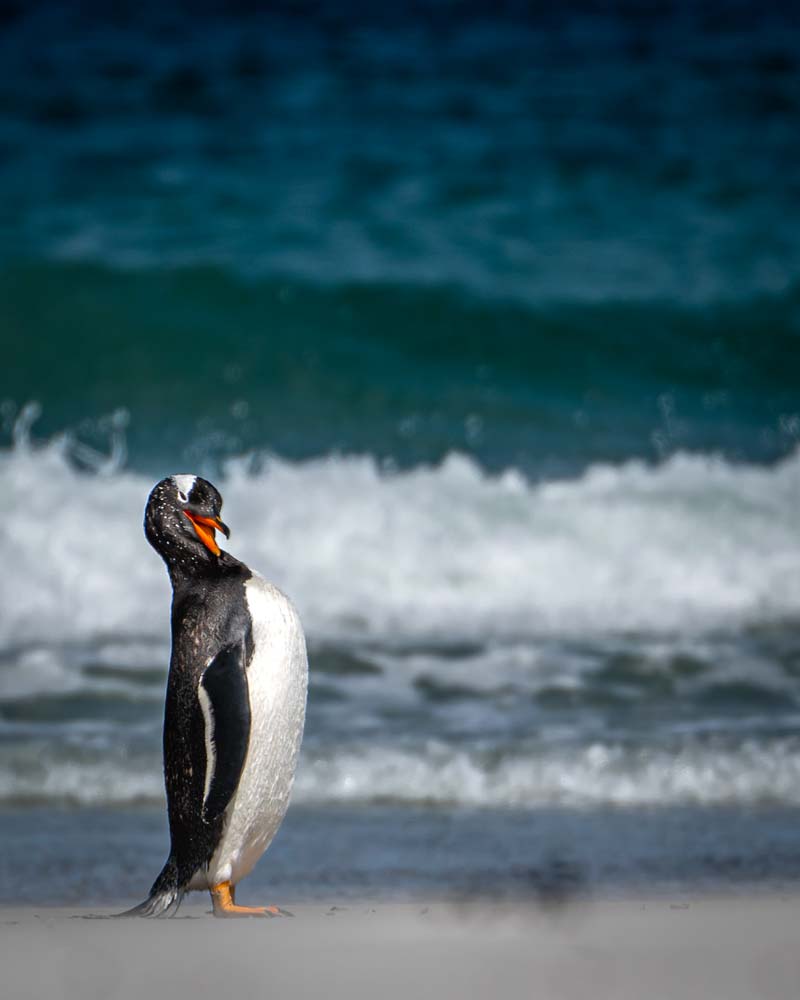
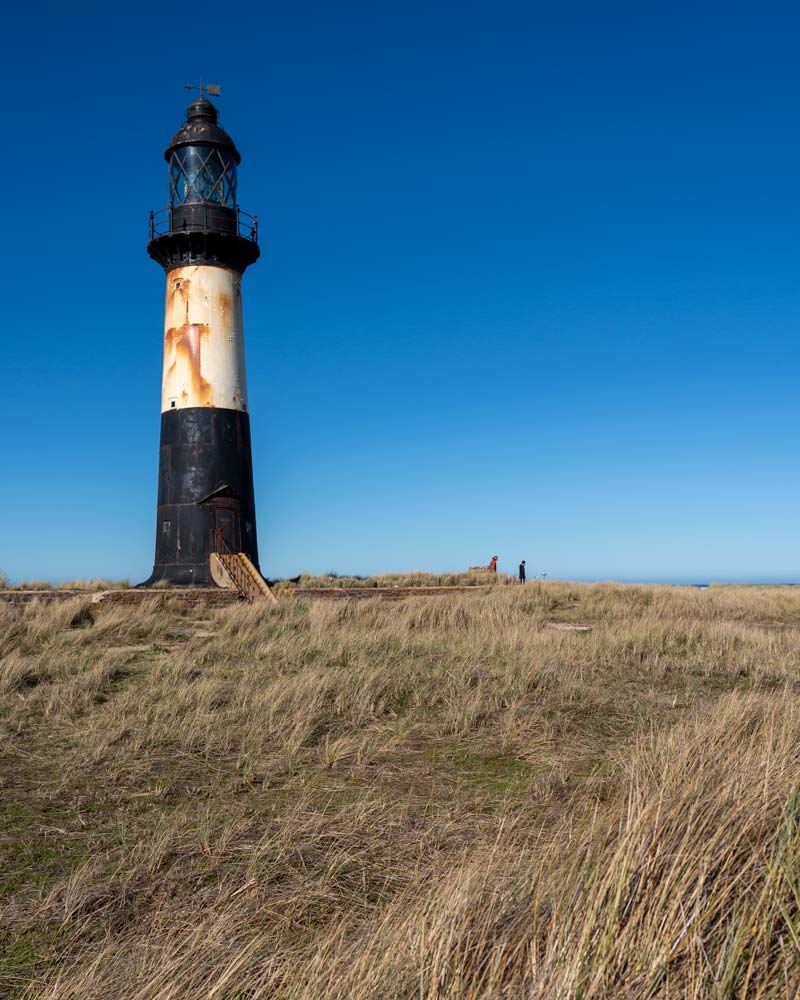
Pulling onto the stretch of Bertha’s Beach, we drove along the sand and parked the car up before the sand dunes. Just beyond, Gentoo Penguins were running in and out of the water before heading up to their colony in the dunes. Sheep pottered around, as they seemed to everywhere in the Falklands, and in the distance, some people from the base looked to be surfing.
A pod of white and black dolphins were dancing in the waves, and as we got closer to admire them a group of board-short wearing swimmers appeared, clearly a lot braver and more acclimatised than me.
We spent the afternoon admiring the wildlife, strolling along the beach, and chatting more about day-to-day life here. I found my conversations with the locals really interesting and probably asked more questions than I should have. It’s strange how fascinated and warped our opinions can become of places so far away, which reminded me of a comment Tina had made a few days earlier about how one visitor had been surprised she ‘didn’t look like a penguin’.
On the way back into Stanley, we drove past fields of Pale Maidens, the white national flower of the Falkland Islands, before arriving at the high tussock grasses that surround the lighthouse. We were looking for the sea lions that rest here, and although we didn’t find any on the rugged coastline, it was fascinating to hear the stories of the lighthouse. It had been Dan’s grandad who had been crewing the station the day the Argentinian vessels were first spotted, and he stayed there guarding it until they landed and entered the lighthouse.
That evening, I prayed for the weather to behave for kayaking tomorrow, as I cooked a pizza from the local supermarket and had an early night. The other group at Lafone had left the day before, and I was back to books and dinner for one and early nights.
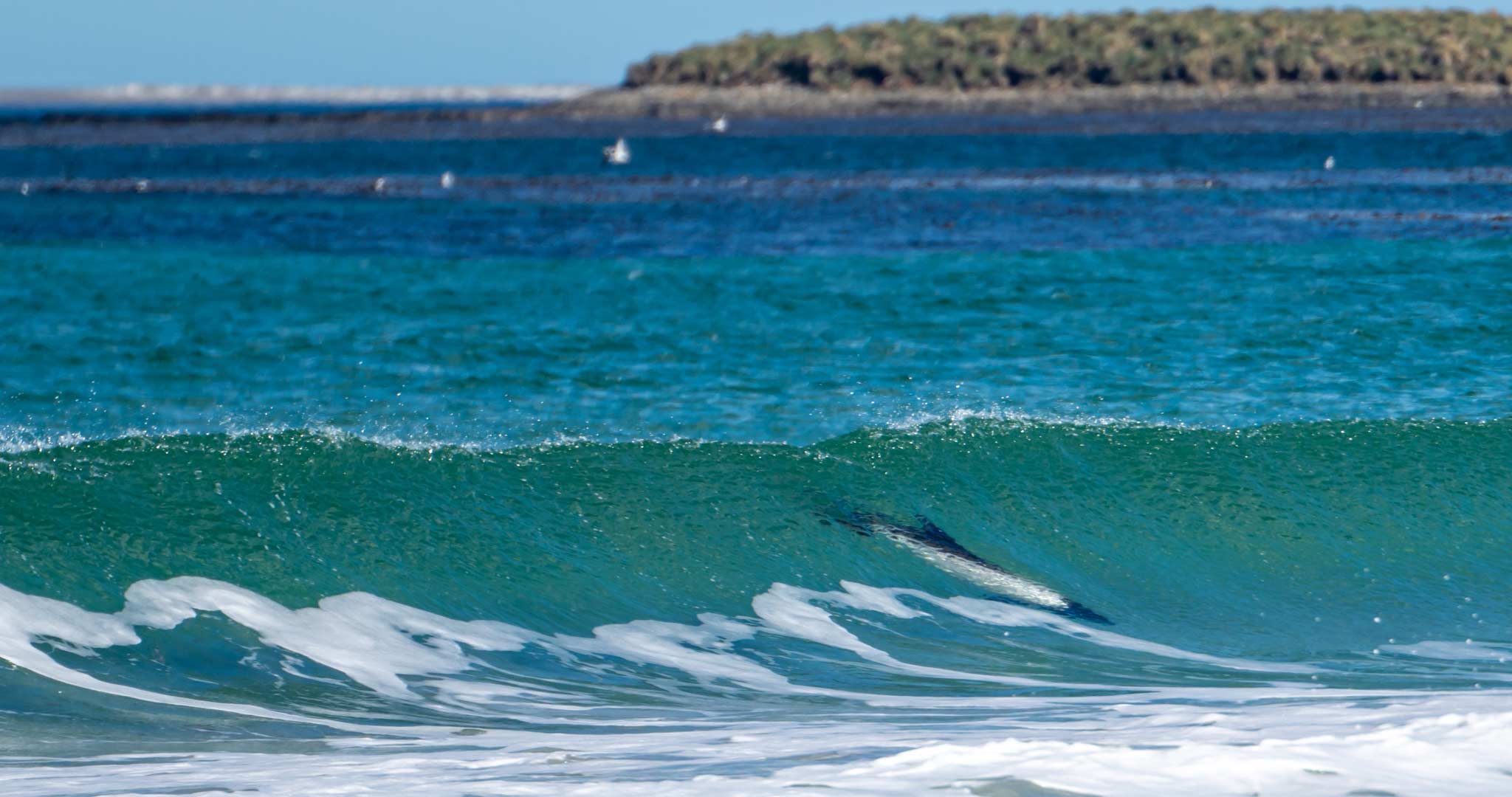
Day eleven – Sea Kayaking in Stanley
There was a little low-hanging mist outside the window as I grabbed my packed lunch and said my goodbyes to Arlette. Dan’s jeep pulled up with a rack of Kayaks on the back, and I got pretty excited that it was going to happen.
I’d seen videos of the Sea Kayaking here, where pods of dolphins would dance alongside you, and seals would pop up to say their hellos. Of course, no wildlife encounter was guaranteed, but my happy place is out on the water, so either way, I was excited.
Sea Kayaking on these choppy waters can be quite a challenge, and we geared up more than I ever had before. Starting from a small inlet, the waters were still and flat at first, the biggest challenge being not to get the paddle stuck in the beds of Kelp. Before leaving the channel and heading out to rough waters, we stopped at a cabin to eat our packed lunch and have a warm coffee.
The cabin was, in fact, a Scout Hut, and Dan told me about fun campouts they had enjoyed there as kids. The couple who looked after it was also there and gave me a brief tour, I imagine kids growing up here are a lot more outdoors ready than us city dwellers. A seal popped up out of the water, a fish in its mouth, and danced around momentarily.
We continued on, and as we left the calm waters, the choppy sea and winds got more aggressive. We darted across the most violent stretch of water, heading for a beach where a few penguins were waddling around. There wasn’t much wildlife out for us that day, and I didn’t get my dream dolphin experience. What was cool, though, was sailing by some of the shipwrecks in the harbour, especially Lady Elizabeth, a massive chunk of iron that had begun life in England and was now stuck on a sandbank here, slowly decaying. There is apparently discussion to turn her into a museum, though it seems quite a challenging undertaking to me.
Dan dropped me back, and I’ve got to say, my two days with him were awesome. He’s a great guy, with lots of good conversation and some fantastic plans to grow his company with plenty of more activities in the future. I’d really recommend if you are spending some time in Stanley that, you book a tour or activity with Falkland Outdoors and support his growing venture, as good human company in the Falkland Islands is as valuable as time with penguins.
After a quick shower and outfit change, I excitedly dashed into Stanley to meet Silvia. We had flown in together and been on separate adventures since we’d arrived, and I was excited to hear all about her trip as we had visited different islands. Silvia was staying at the Waterfront Boutique Lodge, which had an onsite restaurant. Grabbing a table, a fish dish, and a G&T, I talked like I never had before – which was kind of true, having barely seen another visitor throughout my trip.
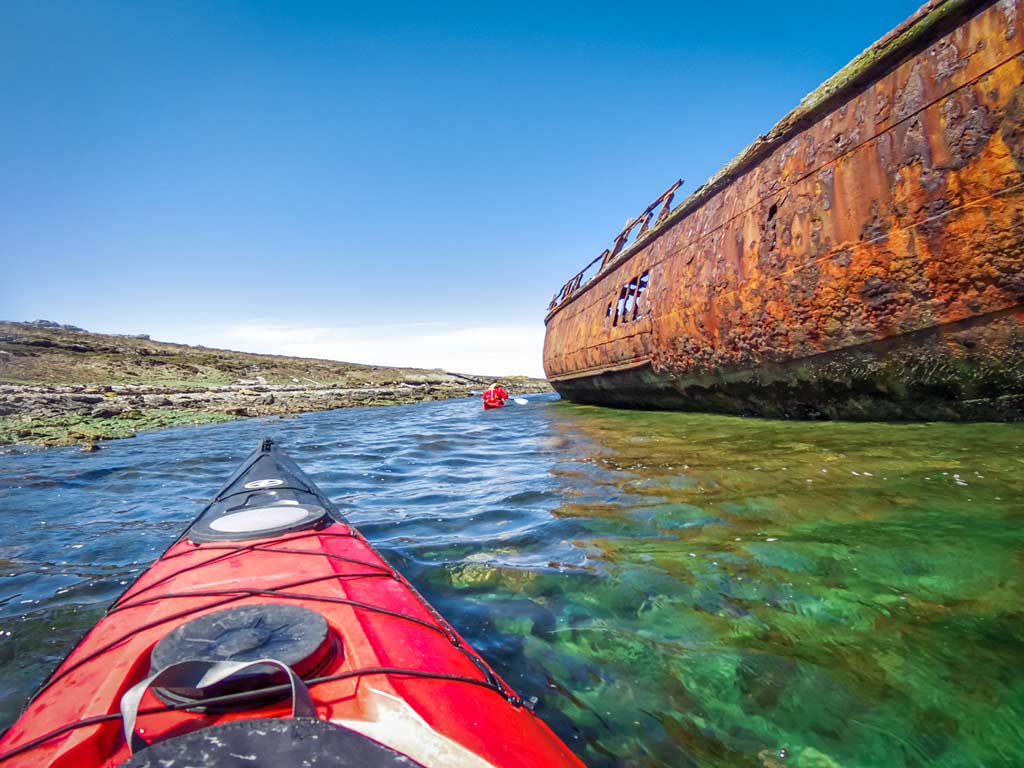
Day twelve – Cape Bougainville and (not) Kidney Island
My driver/guide for today was Ken ‘Carrot’ Morrison, a popular local who offers tours to various spots on the island. Sadly, we weren’t able to go to where we had first decided, as the landowners didn’t want visitors at that time. With so much of the Falkland Islands being privately owned, it was something hard for me to wrap my head around. You always think of nature and national parks as being public spaces, but in the farm-line-defined world of this archipelago, that was rarely the case.
Instead, we headed off to Cape Bougainville on the far side of the island. Shags, penguins, sea lions and seals sounded great to me, especially the latter, as I hadn’t seen many yet.
Just after arriving at Cape Bougainville, the heavens opened, and the hideous hailstones I’d experienced only once before on the trip started to strike. Their size and aggressiveness make you search for any kind of shelter you can, which is not always easy in a land without trees.
Luckily, the wildlife more than made up for these brief but more than once icy attacks. There were many different types of penguins here, including the rockstar looking Macaroni Penguin, my first time spotting these yellow-haired lookers. There were also sea lions bouncing up and down the rocks or being thrashed about in the water while hundreds of Cormorants flew around, making their nests.
I spent a good few hours just marvelling at the dramatic scenery and soaking up my last moments of wildlife before the harsh weather conditions became too much. I jumped back into the jeep, and Ken whisked us back to Stanley. I was sure our boat tour to Kidney Island would be cancelled that evening, given the fierce weather.
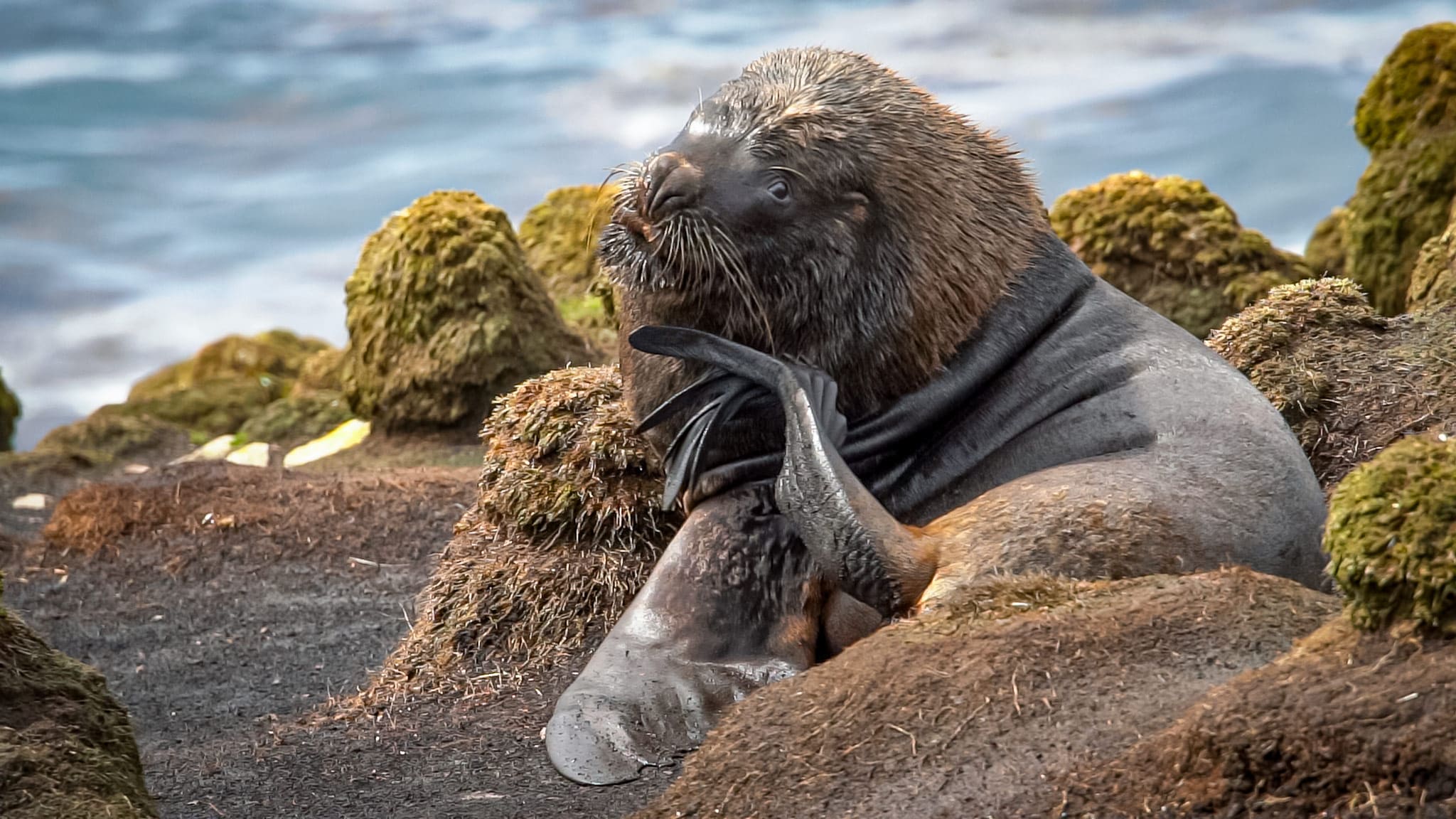
Luckily, The Falkland Islands are renowned for their microclimates, and as we came across the mountain range, the sun was shining. The weather had been sunny and dry in Stanley today, and in fact, it was now the best weather of the whole week. Sadly, the rain had hit Kidney Island, and the tour was still not going ahead. A short boat ride from Stanley would have taken us here, for what I had been promised would be an unforgettable last night of the trip.
As I didn’t make it, I can tell you much more than what I have heard – it’s a beautiful place, named after its shape. While it’s got plenty of Penguins, the magic of the islands is supposedly at sunset when tens of thousands of shearwaters, a type of bird, flock back to the island and dance in the skies, almost taking over your whole view because of the sheer number of them.
With our evening plans cancelled, Silvia and I decided to head for a fancy dinner and reminisce over our trip. It’s an emotional evening, both of us failing to find the right words to summarise how we feel. I feel like I’ve been here for months and am ready to go home, but I also feel like I could stay for months longer and explore every single one of the islands. We share the similarities we’ve felt throughout the tip: the unbelievable highs, the lonely times, and the emotional moments of simply being alone with only your own thoughts. We cheer with our G&Ts to our time on this remote, rugged land, so special and so unlike anything we have experienced before.
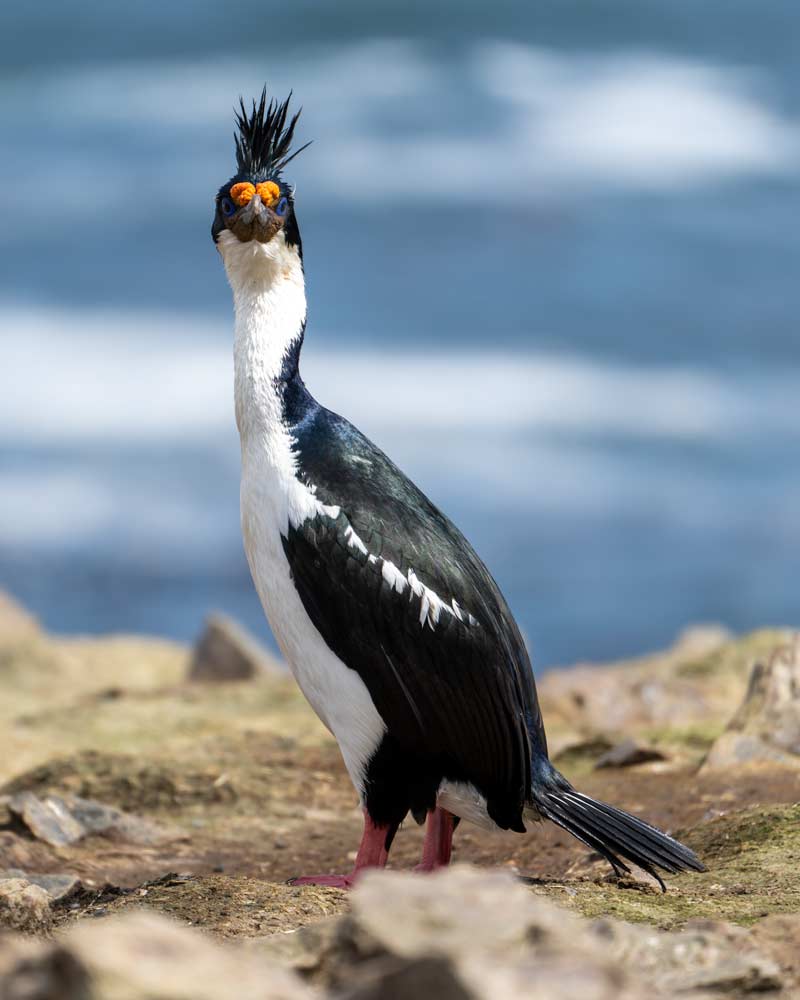
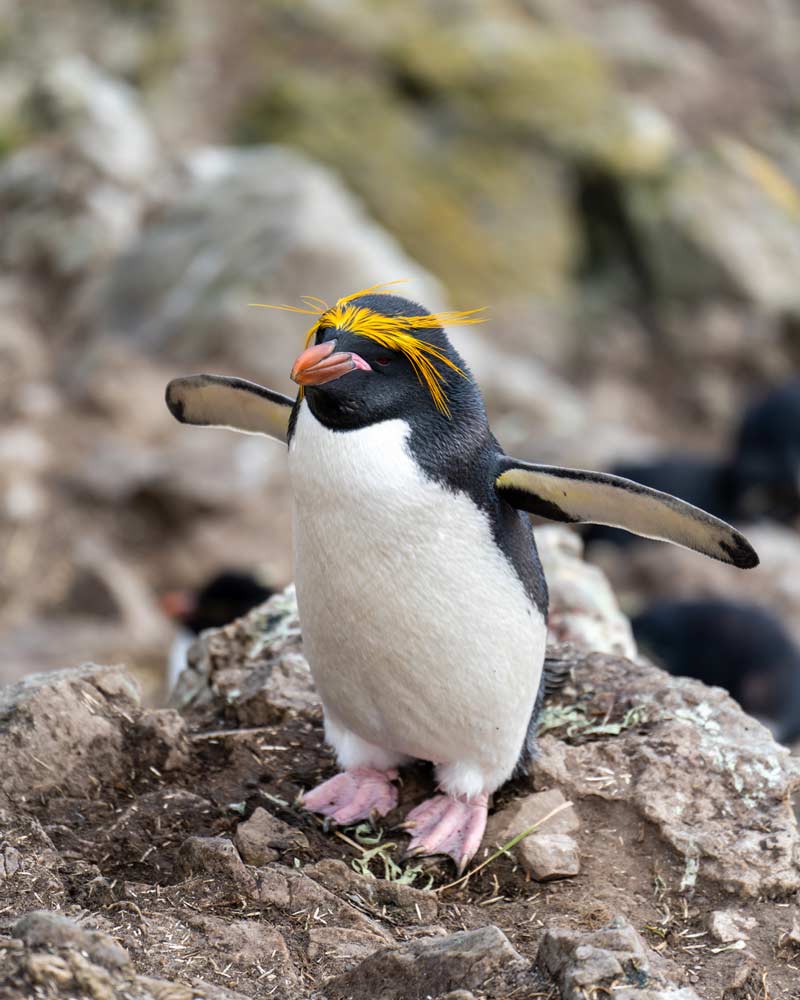
Day thirteen – is it really all over?
Just after six am, I woke up to the warm sun streaming through the wide windows of my cosy front room. The bed sheets were so encompassing it was hard to believe the time had come to pack up and depart home to what seemed more like another planet than a different country at this point.
My clothing smelt slightly of the seal as I stuffed it into my bag, an excuse I used for the tear I could feel forming in my eyes. I imagined that on our slightly delayed AirBridge flight, the majority of passengers would be troops on their way home, ecstatic for a break from deployment. But for me, it was a bittersweet goodbye.
My brain knew I needed to go home for work and WiFi, but my heart had got quite comfy here, enjoying the simple life and feeling relaxed.
I buttered my toast for the final time in Arlette’s kitchen, dumping extra of her homemade marmalade onto the thick bread. As we both drank warm mugs of coffee while having a natter, I realised just how special this place was.
Robert, Elaine, Tom, Tina, Rachel, David, Dan, Carol, the list of names was endless – how many other places in the world can you say you’ve travelled and knew the name of every pilot, chef, hotel staff member and guide you had met.
For me, the Falkland Islands was the first, and perhaps only place, that will ever happen.
It had been an emotional trip for many reasons: incredible highs, hard, lonely lows, a lot of personal soul-searching in quiet times and a fair chunk of nostalgia for my childhood. But the underlying feeling was of joy, joy that I had said yes to an assignment that I never expected would tug on my heartstrings so much.
I was shaken out of my distant daze by the gravel growling on the drive under the weight of a Land Rover. Tina, with her familiar beaming smile, was here, and what had started to feel like a six-month jaunt across the archipelago suddenly seemed like the much quicker two weeks it had actually been.
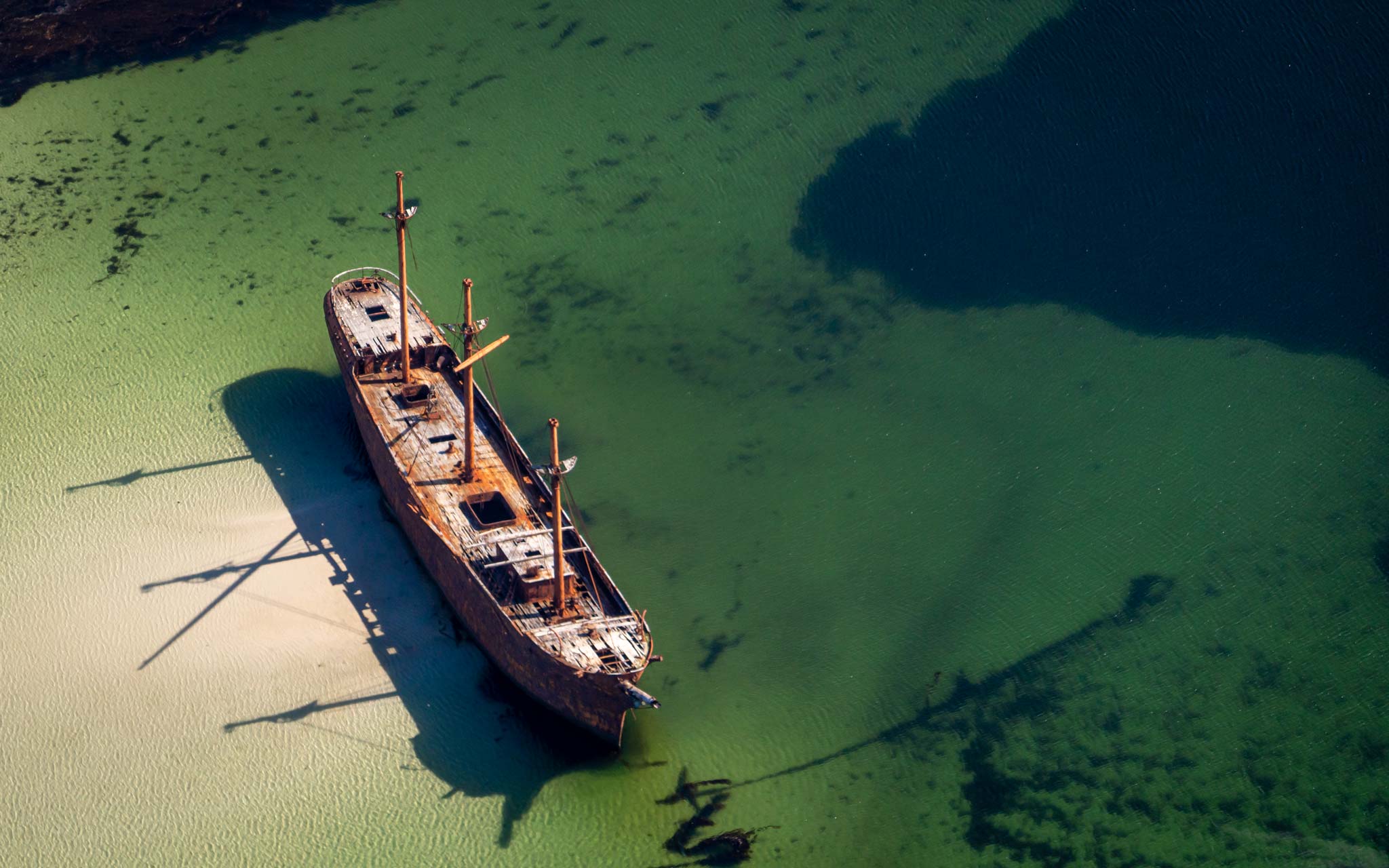
I hugged Arlette twice; in fact, like you hug a relative, you’re not sure when you’ll be lucky enough to see her again, and I slipped some of her famous baking into my carry-on. We swung by to pick up an equally teary Silvia, who had been on her own solo rollercoaster, it seemed and headed off down the Mount Pleasant road for one last time.
The unlaid sections seemed smooth to me now, the sighting of a lonely tree in the distance peculiar, and 40 miles per hour felt like doing a Formula One final lap.
In the car park of the military airport, I felt we all shared an emotional goodbye like a happy ending movie, but surrounded by barbed wire and camouflaged jeeps, it likely would have looked more like an evacuation scene on the silver screen.
The terminal building welcomed us with dance music playing behind the friendly army lads at the check-in desk, and I scored lucky with a window seat. The tired terminal was overwhelmed by the smell of freshly sprayed Lynx, and we all waited on plastic chairs as announcements for Majors and Sergeants came over the tannoy.
By now, this all seemed normal, or actually maybe even the opposite. The airport had an actual runway. I didn’t know my pilot’s name, and there was some sense of procedure here. My idea of normal might have been warped during my two weeks in the Falkland Islands.
Before boarding, we chatted with two veterans from the 1982 war whom we had met on the flight over, both exclaiming how different and developed Stanley was now and telling us their stories. Soon, by row group, we were called forward to find our seat for the next 18 hours.
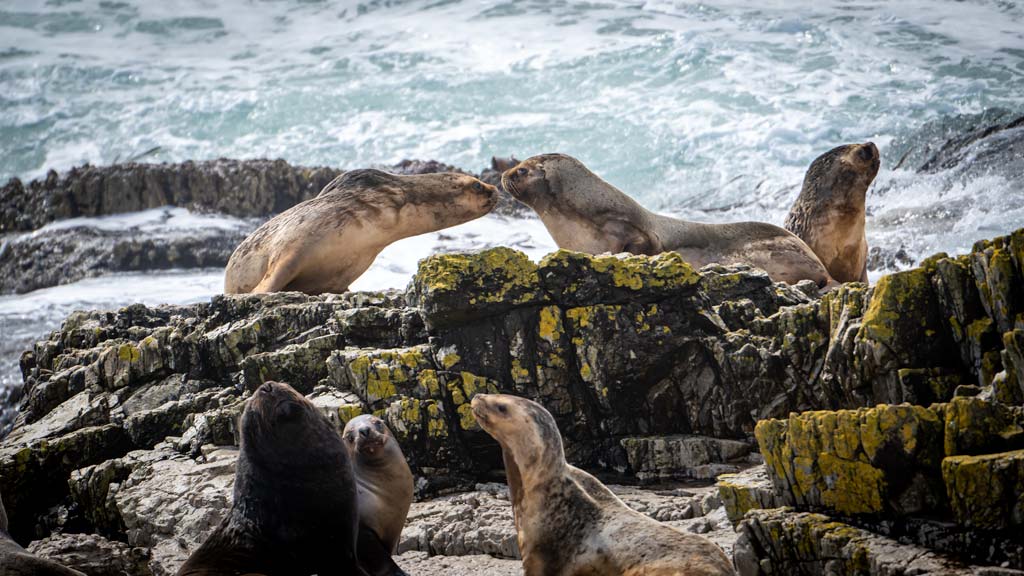
As the replacement jet, a wet leased Jet2 plane of all things (minus the Jess Glyne welcome) started to roll up the runway; I looked out the window hoping one day I would return to this extraordinary land.
In the corner of my eye, a group, likely cadets, stood by the runway. One man dressed as a penguin waved an ‘enjoy your freedom’ sign at the plane as they all jumped up and down, waving us off.
And for me, that sums up the paradox of the Falkland Islands, a far-off land in an almost forgotten time. For some, it’s an intrepid adventure which rewards you with wildlife and vistas that many will never see.
For others, it’s a bleak sentence that they can’t wait to escape, and those image searches I did before my visit are the PR disaster that epitomes that.
But for me, it was everything I wasn’t expecting in the best of ways. It was joyful, dramatic, and a true off-the-beaten-path adventure – it was familiar yet incomparable at the same time.
Perhaps indeed one day I’ll return, but next time I’ll be taking that new flight I think.
As Silva and I sat in Cape Verde airport on our stopover, trying to re-acclimatise to free wifi and cafe menus, she summarised it perfectly – visiting the Falkland Islands was like being part of an elite club, where everything was a bit special and different, and it wasn’t until our membership was revoked that we realised just how much we had craved to be members, even though we had never known it.
I hope you enjoy your ‘temporary membership’ of the Falkland Islands as much as we did; it truly is a land of unknown adventures.




It looks and feels like Falkland is a mix of Faroe Islands (for the remote treeless wonderful landscape and unpredictable weather) and Galapagos (for the abundance of wildlife). How expensive is it? All those plan rides, tours and remote guesthouses sound expensive
hello Dan
I find you blog most interesting, thank you for putting it together, gives us a insight of the place, as far as we went was Stanley, to the coast and to the King Penguins, we both very keen photographers, is a tripod necessary? as to me its more to carry could do with as less as possible, sorry to ask so much
we have been to the Falklands, on a cruise last year, Jan Feb 2020, we was going back to Falklands this year but as you know nobody can travel,
we are a lot older then you and in two years we will be much older, you ask why two years, as the rate things are going it will still not be safe after this year,
I was worried about how far we had to walk to places, but from what I have read it don’t seem that far, looks as far as you walk is to the small plane, can you give us any hints, like as I mentioned walking how far to different places, places ot stay we are not bothered, from what you say it seems very cosy and lovely people on there , thank you again for showing and sharing your adventure
Hi Elaine,
I’m so sorry for the delay in response, seems the comment was being held in the queue for some reason.
I didn’t use my tripod much to be honest, only for long exposure shots of which I didn’t do many. Likewise, with the walking about and sometimes strong wind I didn’t really want to carry it around with me. A good tele-photo lens with a stable hand I think is more than enough for capturing the wildlife, although my videos did suffer not having the tripod with the wind sometimes.
It depends which islands you went too, on some of the smaller ones the plane lands outside the guesthouse doors, others you’ll be driven from the landing strip to the accomodation. Then, it depends on where you go really – in some places I could step outside to the penguins and wildlife and easily not walk more then a few hundreed metres all day, in other islands, where it’s large and not as much to see, I walked extensively, but mostly it was flat and usually the cabin would pick me up and drop me off where ever i wanted. Sometimes they offered tours by jeep. I think you could absolutely pick the islands and destinations to suit your walking preferences, and I’m sure the lovely folks at the tourism board could even help you put a route together based on that.
First off, the photos look astoundingly surreal and out of this world! It’s like the sceneries were only captured to be viewed on a movie screen! The beautiful art of nature plus great photography equals these masterpieces! Thank you for sharing these beautiful places with us even though it’s only through virtual but you made us inspired and motivated to work our asses off to even just visit this place!
Thanks so much, it was a very special place indeed!
What an astounding website Dan. This will most likely rouse individuals to book an outing to our Islands. Excellent photos and spot on with your depictions of all that you saw. I completely delighted in facilitating you and expectation you return one day . Sending another embrace.
Freek Buzz
Interesting article, Dan. I haven’t been thinking about going to that place, but seems you changed my mind :)
What a, great blog Dan u certainly done the Falklands justice…. I am so pleased u had an amazing time and I could be a part of it.. Come back and see us again soon my friend…
Thank you Tina – see you again someday there I hope :)
What a fabulous blog Dan. This will surely inspire people to book a trip to our Islands. Beautiful photographs and spot on with with your descriptions of everything you saw. I thoroughly enjoyed hosting you and hope you return one day . Sending another hug.
Thank you Arlette – you were a huge part of my adventure and I’m hoping many more people get to experience the Falkland Islands and your Smoko ;)
thank you for this beautiful blog which gives us ideas and many information to travel. very nice pictures thanks a lot